Did you know, there are 35 bridges over The Thames in London? No, me neither so this was a really interesting article to research. From Hampton Court Bridge in the west (just within the Greater London boundary) through to Tower Bridge there are road bridges, railway bridges and footbridges too.
Have a read through, admire the photos, then let us know which is your favourite. PS You can’t choose Tower Bridge as we all know it’s amazing. I’d have to say Albert Bridge when illuminated at night is a real delight.
Image by Pierre Blaché from Pixabay
Hampton Court Bridge
Date: 1933
Info: The most upstream crossing of all of the Thames bridges of Greater London is the ‘modern’ Hampton Court Bridge. It is a Grade II listed concrete road bridge faced in white Portland stone and red brick to fit in with the style of Hampton Court Palace.
The London architect Sir Edwin Lutyens was involved in the design. He also designed The Cenotaph war memorial on Whitehall and was on the Imperial War Graves Commission committee who designed cemeteries and memorials to the war dead. (We touched on this in the article about Max Gill’s London Theatreland map.)
I called this the modern bridge as there were three predecessors. The first was a privately-owned Chinoiserie-style wooden bridge that opened in 1753 (see image below). The second bridge was built in 1778 and was also wooden. And the third consisted of wrought iron lattice girders and opened in 1865. While it wasn’t admired for its finesse, it was a profitable toll bridge.
Today’s bridge was opened by the Prince of Wales (who became King Edward VIII) on 3 July 1933, on the same day as the opening of Chiswick and Twickenham Bridges.
Nearby: The Grade I listed Hampton Court Palace was one of Henry VIII’s favourite royal residences.
Interesting Fact: This is the only bridge in London that crosses over into another county (Surrey).

Kingston Bridge
Date: 1828
Info: 1.5 miles downstream, Kingston Bridge is a Grade II* listed stone road bridge. There were earlier wooden bridges with the last collapsing in 1814 due to a severe frost.
In 1914 the carriageway was widened from 25 feet to 55 feet, and the Portland stone cladding was added. It was widened again in 2000 so is now 79 feet wide.
Nearby: The 10th-century Coronation Stone can be seen on the High Street, near the Guildhall (more below).
Interesting Fact: Kingston – meaning ‘King’s estate’ – was an important location in medieval times. It’s thought seven, or maybe eight, Anglo-Saxons kings (AD 900-1016) were crowned here whilst seated upon the Coronation Stone.

Image by rachelmatthews7 from Pixabay
Kingston Railway Bridge
Date: 1907
Info: This cast-iron bridge crosses the River Thames on the reach above Teddington Lock. It carries the South West Trains looping branch line from London Waterloo to Shepperton and Richmond, linking Kingston and Hampton Wick stations.
It was designed by John Wykeham Jacomb-Hood (1859 – 1914), Engineer for the London & South Western Railway who also designed the Richmond Railway Bridge. And it was constructed in 1907 to replace a cast-iron bridge designed by J E Errington in 1863.
Nearby: Wander into Kingston town centre to see the David Mach sculpture ‘Out of Order’ on Old London Rd. It’s a row of red telephone boxes that appear to be toppling over like dominoes.
Interesting Fact: The bridge has five arches, three of which span the Thames; one arch on each side spans over dry land, and that on the Kingston side has a road underneath.
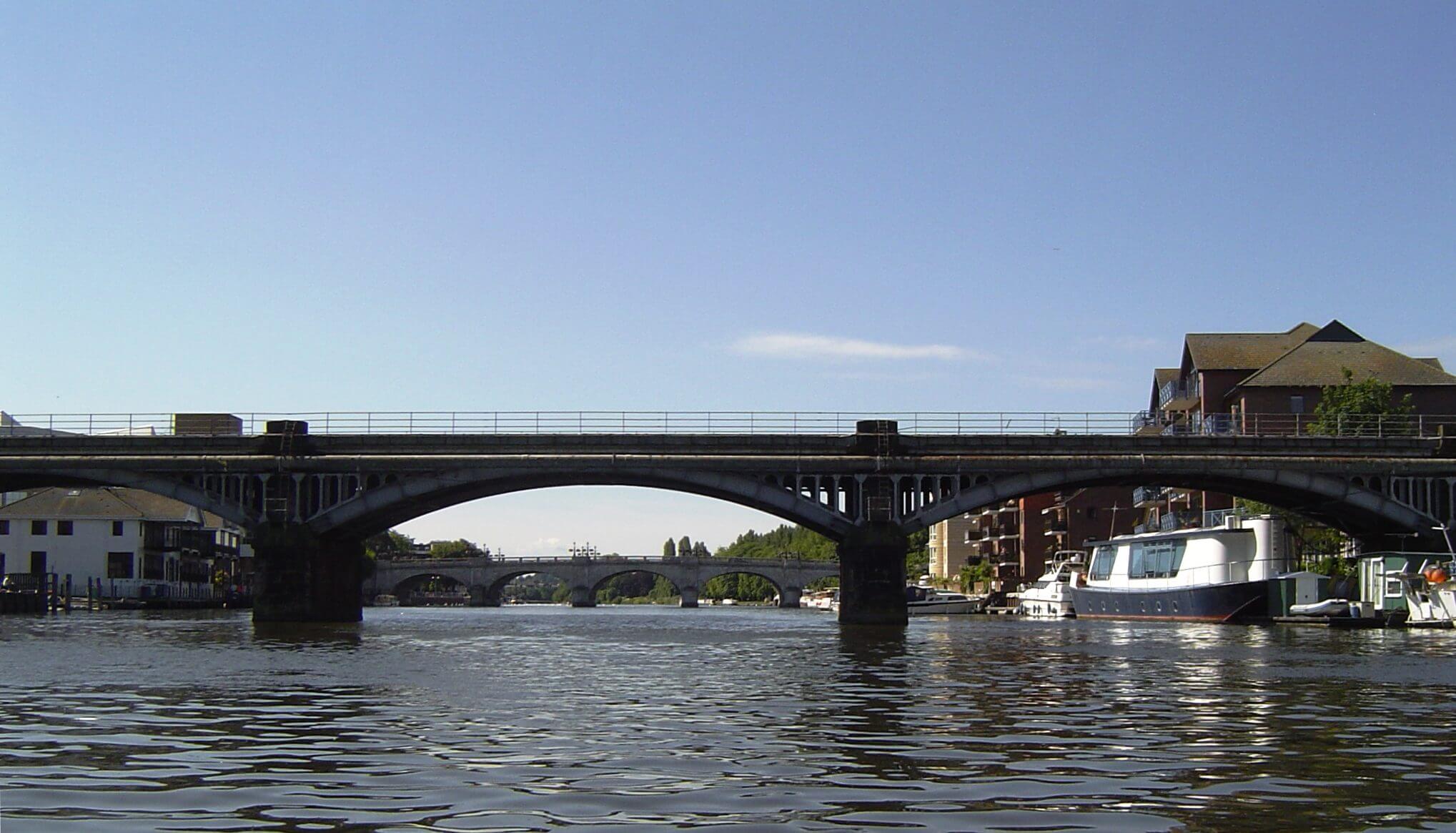
Teddington Lock Footbridges
Date: 1889
Info: These two Victorian Grade II listed bridges, with a small island between them, replaced a ferry.
The western bridge is the more attractive one as it’s a suspension bridge that links the island to Teddington. The eastern girder bridge connects the island to Ham on the Surrey bank.
Nearby: National Trust’s Ham House and Garden
Interesting Fact: Teddington lock is non-tidal now, but that wasn’t always the case.

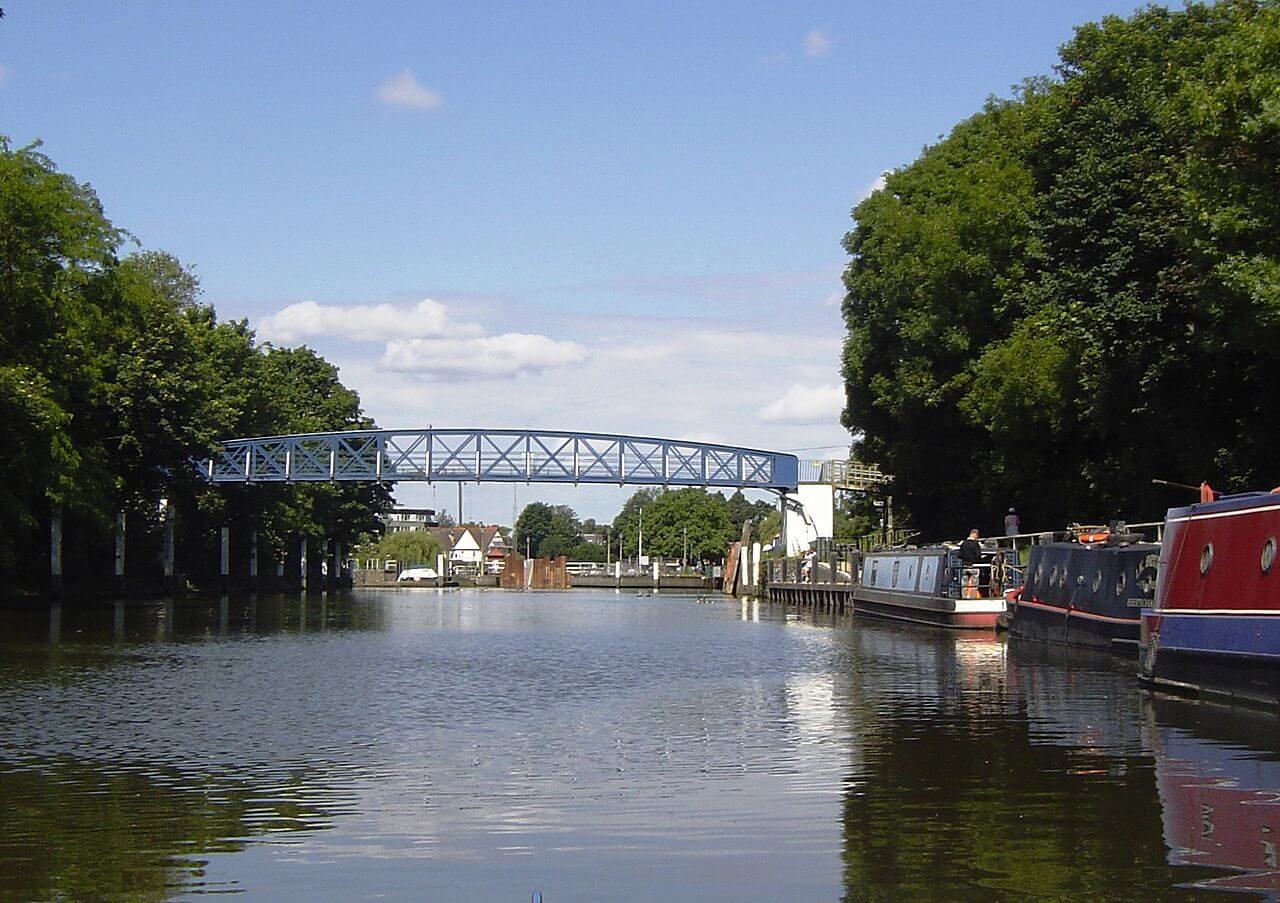
Richmond Bridge
Date: 1777
Info: The only London Thames bridge from the 18th century still in use, Richmond Bridge is the oldest surviving Thames bridge in London. It is, therefore, Grade I listed – the highest level of preservation.
It is a 300 ft Portland stone bridge with five arches that was built to replace a ferry crossing. It was widened in the 1930s by an extra 11 feet, and you can see the join under the arches. Stronger steel and concrete foundations were added during this time, and the central ‘humpback was reduced as well.
Do notice the milestone obelisk on the Richmond side of the bridge.
Nearby: The Royal British Legion Poppy Factory should be reopening for visitors in 2021. They provide employment support for wounded, sick and injured veterans. I visited years ago, and it was a fascinating place. Richmond Park is also close.
Interesting Fact: Before Tudor times, Richmond was known as Sheen (a name still in use further from the river). Henry VII built Richmond Palace here, named after Richmond Castle in Yorkshire (he was formerly the Earl of Richmond). He died in the Palace in 1509, as did Queen Elizabeth I in 1603, after spending much of her life in the palace. She went hunting in what is now Richmond Park. Only the palace gatehouse survives.
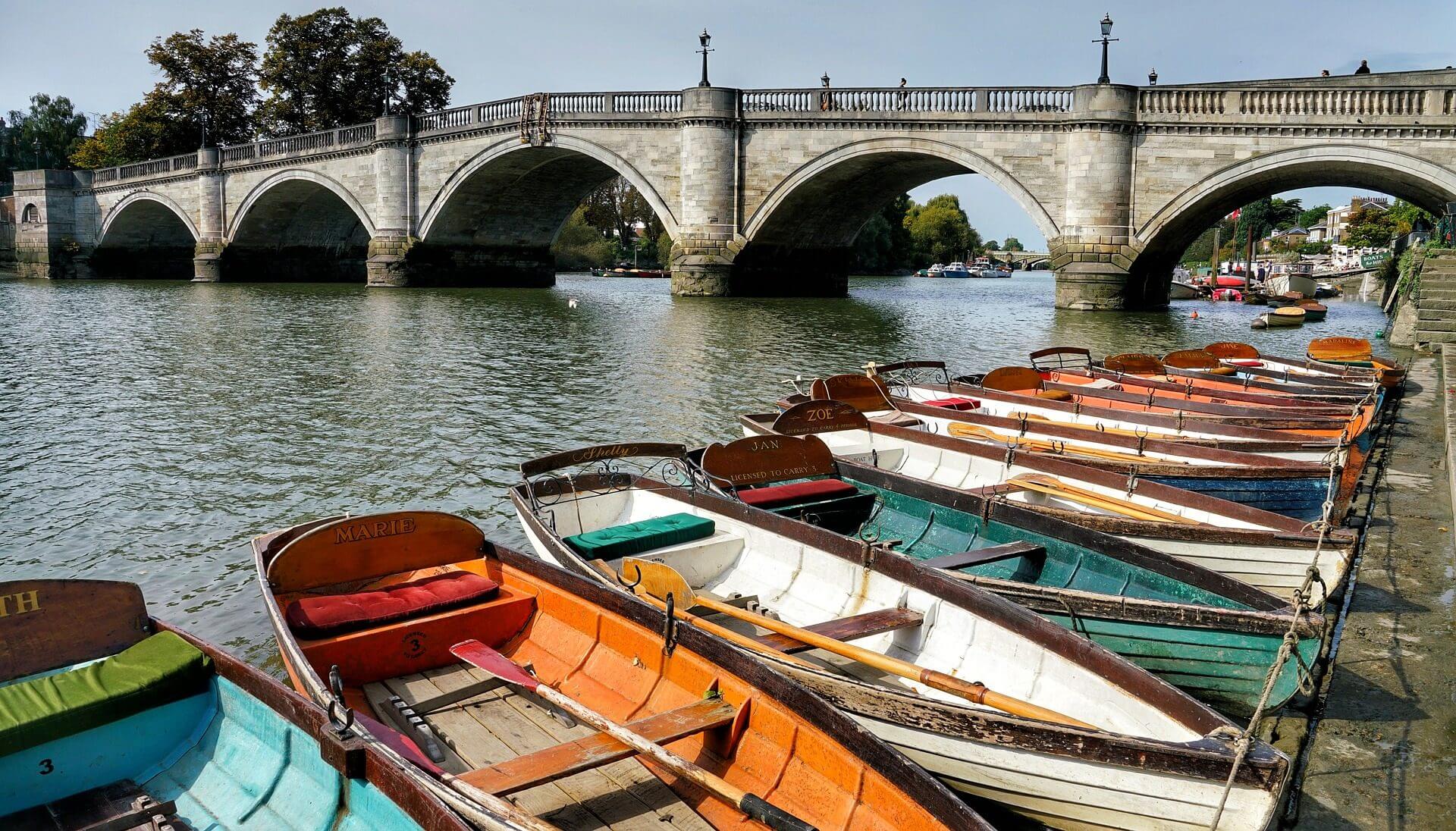
Richmond Railway Bridge
Date: 1848
Info: Joseph Locke designed the original bridge with three 100-foot cast-iron girders supported on stone-faced land arches with two stone-faced river piers. He also designed Barnes Railway Bridge and was ranked alongside Robert Stephenson and Isambard Kingdom Brunel as one of the major pioneers of railway development.
Nearby: Get off the train on the west side at St Margaret’s station, and it’s a short walk to Turner’s House in Twickenham.
Interesting Fact: The bridge and the approach viaduct, which crosses Richmond’s Old Deer Park, was declared a Grade II listed structure in 2008.
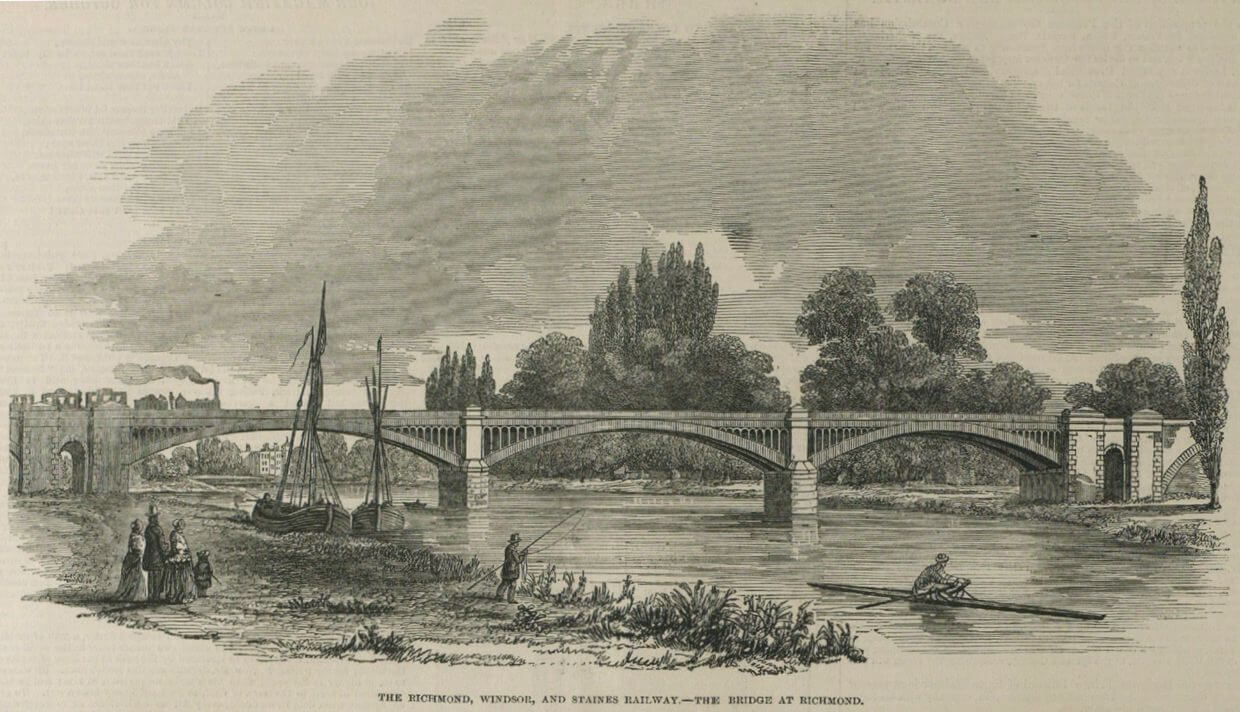
Twickenham Bridge
Date: 1933
Info: This Grade II listed stone road bridge was built to relieve the pressure of traffic over Richmond Bridge as it was so old. It has three reinforced-concrete arches with Art Deco embellishments.
Designed by the same architect as the old Wembley Stadium (Maxwell Ayrton), the bridge incorporates three permanent hinges enabling the structure to adjust to changes in temperature; the first reinforced concrete bridge structure in the UK to use such an innovation.
Nearby: Twickenham Stadium, the home of England Rugby.
Interesting Fact: In 1992, the first Gatso speed camera in the United Kingdom was launched on Twickenham Bridge.

Richmond Lock and Footbridge
Date: 1894
Info: When the old London Bridge was demolished in 1832, the removal of the palisades, constructed to protect the bridge, resulted in the tides on the Thames rising and falling far more rapidly than they had done. This, along with dredging of the lower river, meant that for long periods the Thames at Twickenham and Richmond was little more than a stream running through mudbanks. Parliamentary approval was given in 1890 to build the half-lock and weir to maintain a navigable depth of water upstream of Richmond.
The public footbridge crosses the conventional lock and is closed to pedestrians in the evening.
Nearby: The Duke of Northumberland’s family home, Syon House sits within Syon Park and Gardens.
Interesting Fact: This is the furthest downstream of all the Thames locks and is the only one owned and operated by the Port of London Authority.

Kew Bridge
Date: 1903
Info: The first Kew Bridge was privately-built in 1759 when the area was popular with the royal family. George III (who took the inaugural trip over the bridge when he was Prince of Wales) and Queen Charlotte took their children to Kew Palace and Queen Charlotte’s Cottage, both in Kew Gardens, as a summer retreat. The bridge had a lot of traffic, so it didn’t farewell. A replacement was built beside it in 1789 and was, again, opened by George III.
As traffic volume continued to increase, a third bridge was needed. The 75-foot wide granite structure we can see here today was opened in 1903 as the King Edward VII Bridge.
Nearby: The obvious choice here is Kew Gardens, but on the Brentford side there is the London Museum of Water & Steam.
Interesting Fact: The current Kew Bridge was designed by John Wolfe-Barry and Cuthbert A Brereton. John Wolfe-Barry was the architect of Tower Bridge.

Kew Railway Bridge
Date: 1869
Info: A rail crossing between Kew and Strand-on-the-Green (Chiswick), Kew Railway Bridge was built as part of London and South Western Railway’s extension from Acton Junction to Richmond. It’s a Grade II listed wrought iron bridge with five lattice girder spans of 115 feet each standing on decorated cast-iron piers.
Nearby: The National Archives in Kew is an official government archive available to all for research.
Interesting Fact: Strand on the Green Sailing Club has been under the north arch of the bridge since 1964.

Chiswick Bridge
Date: 1933
Info: Built at the same time as Twickenham Bridge (see above), both road bridges carry the A316 which runs from Chiswick High Road to join the M3 motorway at Sunbury-on-Thames.
This reinforced concrete deck arch bridge links Chiswick and Mortlake. It replaced a ferry service that was sufficient until the local populations grew in the 19th century with the arrival of the railways and increased car ownership.
While there are five arches, only two of them are over the river as the outer arches are over the towpaths. The bridge is 606 feet long and carries two 15-foot wide walkways and a 40-foot wide road. At the time it was built, the 150-foot central span was the longest concrete span over the Thames.
Nearby: Chiswick House and Gardens are very grand. The Beatles recorded the promo video for Paperback Writer in the gardens.
Interesting Fact: Chiswick Bridge is the finish point of The Championship Course of the Oxford-Cambridge Boat Race. The exact finish point is actually a stone marker that’s about 370 feet downstream of Chiswick Bridge.

Barnes Railway Bridge and Footbridge
Date: 1895
Info: This Grade II listed railway bridge also has paths for pedestrians to cross the Thames too. The first railway bridge here was cast iron and built in 1849 but was replaced with what we see today in 1895. It has three spans of wrought iron bow string girders.
Nearby: On Gipsy Lane, there is a shrine to 1970s pop star Marc Bolan at the site of his fatal car crash.
Interesting Fact: The Thames Path has to divert because of Barnes Bridge.
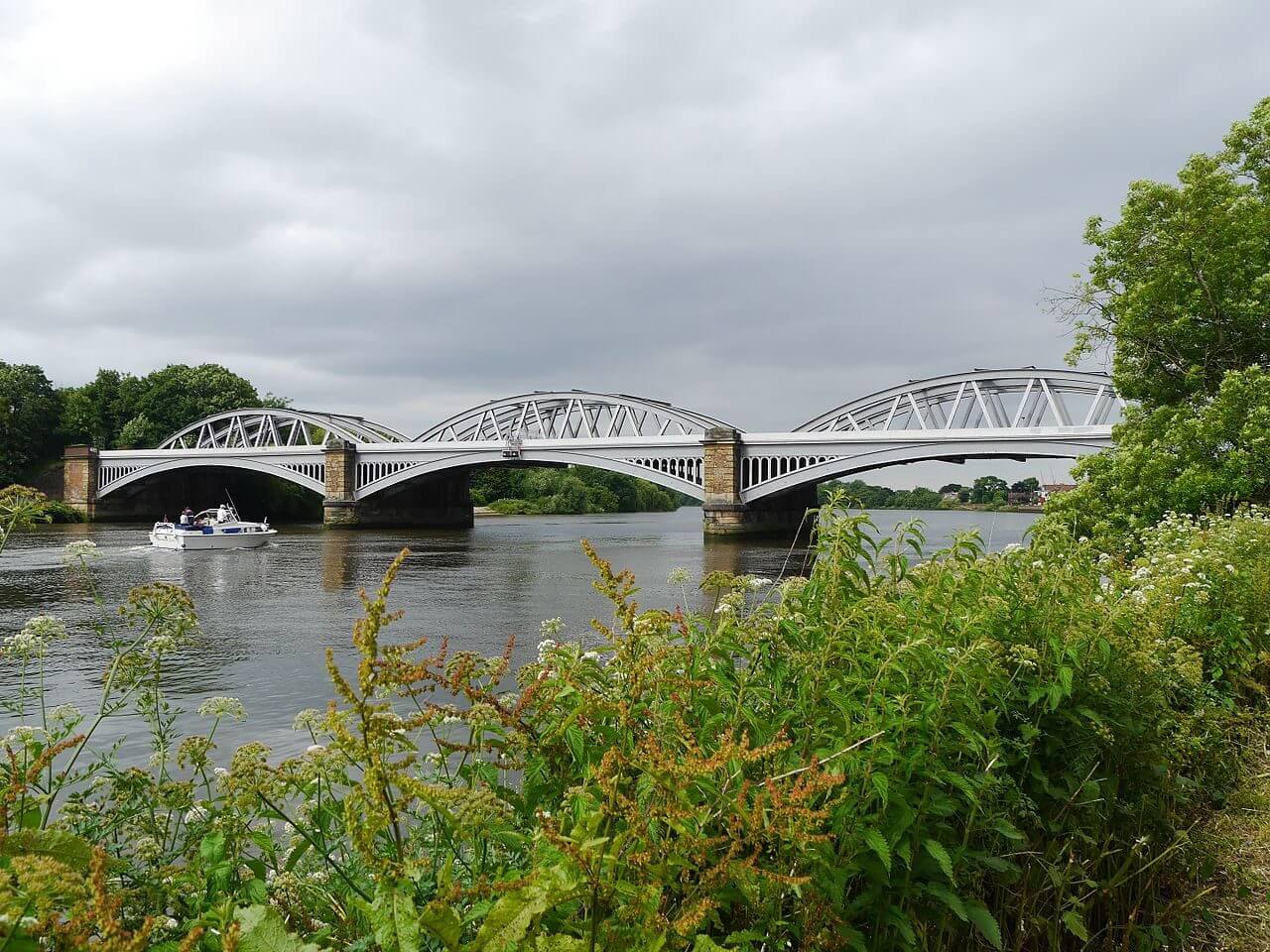
Hammersmith Bridge
Date: 1887
Info: Currently closed because it is at risk of collapse, Hammersmith Bridge is an ornate Grade II listed steel and iron suspension bridge. It’s feared the repair costs could be as much as £165 million. Without the funds available, the bridge will remain closed.
It was built in 1887 to replace an earlier suspension bridge from 1827. It was designed by Joseph Bazalgette whose major legacy is a sewage network for central London as a response to the 1858 ‘Great Stink’. Today’s bridge uses the same pier foundations as the original bridge.
Nearby: Stroll past The Dove pub, and you’ll reach The William Morris Society. Carry on along Upper Mall, and you’ll get to Emery Walker’s House.
Interesting Fact: The 1827 Hammersmith Bridge was the first suspension bridge over The Thames.

Putney Bridge
Date: 1886
Info: The first Putney Bridge was wooden and opened in 1729. It was officially known as Fulham Bridge as the river crossing here connects Fulham and Putney. It is remembered for a suicide attempt in 1795 when feminist writer Mary Wollstonecraft threw herself off the bridge when she found out her husband was having an affair. Thankfully, she was rescued by two watermen and went on to marry philosopher, William Godwin. Their daughter was Mary Shelley who wrote Frankenstein.
This current Grade II listed arch bridge was also designed by Sir Joseph Bazalgette. It is built of stone and Cornish granite. It was widened in 1933.
Putney Bridge is at the start of The Boat Race; there is a stone marker for the actual start line about 420 feet upstream of Putney Bridge.
Nearby: London Wetland Centre is a lovely outdoor attraction.
Interesting Fact: Putney Bridge is one of the only bridges in Britain to be flanked by churches on both ends.
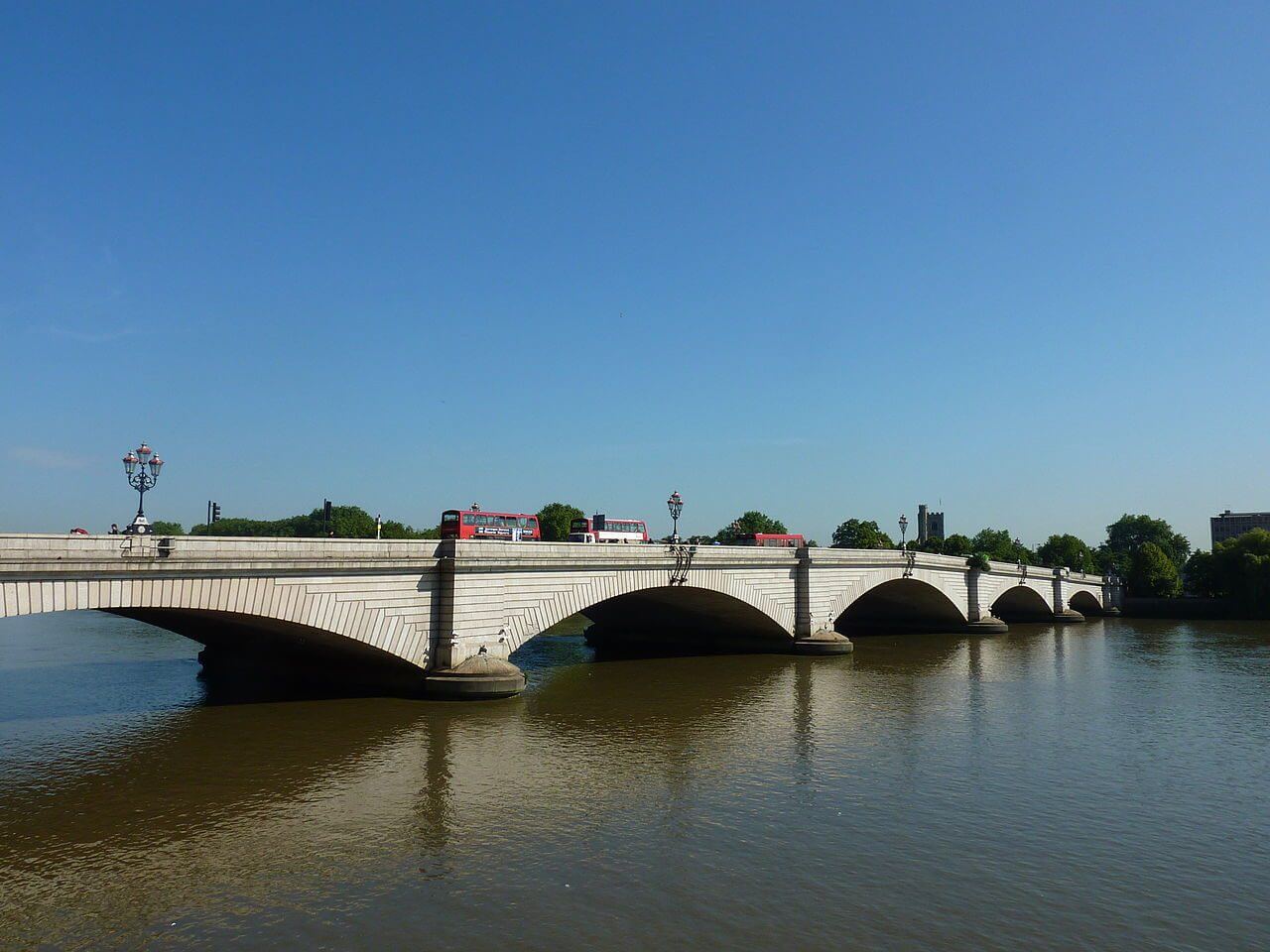
Fulham Railway Bridge and Footbridge
Date: 1889
Info: Close to Putney Bridge, this railways bridge carries the Wimbledon branch of the District Line. It’s a girder bridge with five spans over the river and a further two spans over the southern shore and one on the north. It was designed by Isambard Kingdom Brunel’s former assistant William Jacomb and built by Head Wrightson. They called it Putney Railway Bridge, but the locals just called it ‘the iron bridge’. When it was refurbished in the 1990s, a plaque was added with the name Fulham Railway Bridge.
Nearby: Fulham Palace House and Garden is in Bishop’s Park.
Interesting Fact: Fulham Railway Bridge is one of only three combined rail and pedestrian bridges over the Thames in London, the others being Barnes Railway Bridge and the Golden Jubilee Footbridges (with Hungerford Railway Bridge).
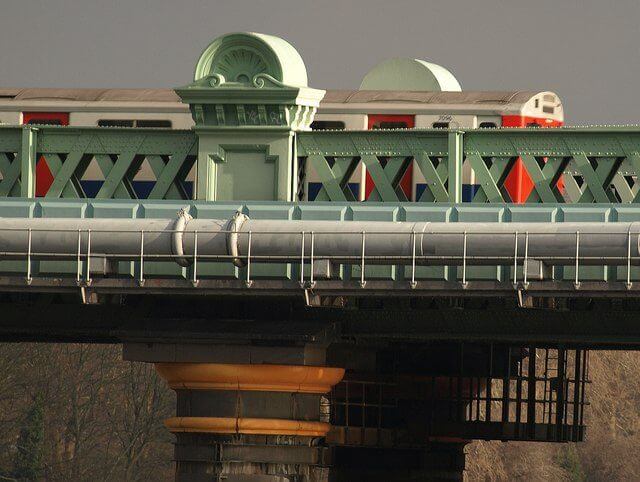
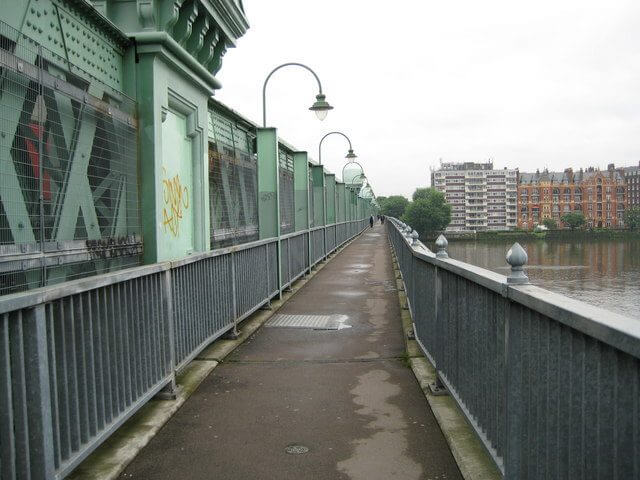
Wandsworth Bridge
Date: 1940
Info: The three-span steel cantilever bridge we see today replaced an 1873 wrought iron lattice truss bridge (see below). It was built in 1940 with distinctive low curves that were intended to reflect the low riverbanks in the area. According to some reports it was painted in light shades of blue as camouflage against Luftwaffe air raids.
The bridge is currently being refurbished so there is reduced access. Overnight closures are needed too during the road resurfacing. After September, the second phase of the refurbishment will move to the underside of the bridge, which should cause less disruption.
Nearby: Battersea Arts Centre is a popular performance space with a courtyard so is still able to have its comedy nights.
Interesting Fact: Wandsworth Bridge marks the boundary above which a lower speed limit on the Thames is enforced. A 12 knots (22 km/h) speed limit is in force downstream from Wandsworth to Margaretness. Because of the number of rowers using the upper reaches of the river, all of the tidal Thames upstream of Wandsworth Bridge is subject to a strictly enforced speed limit of 8 knots.

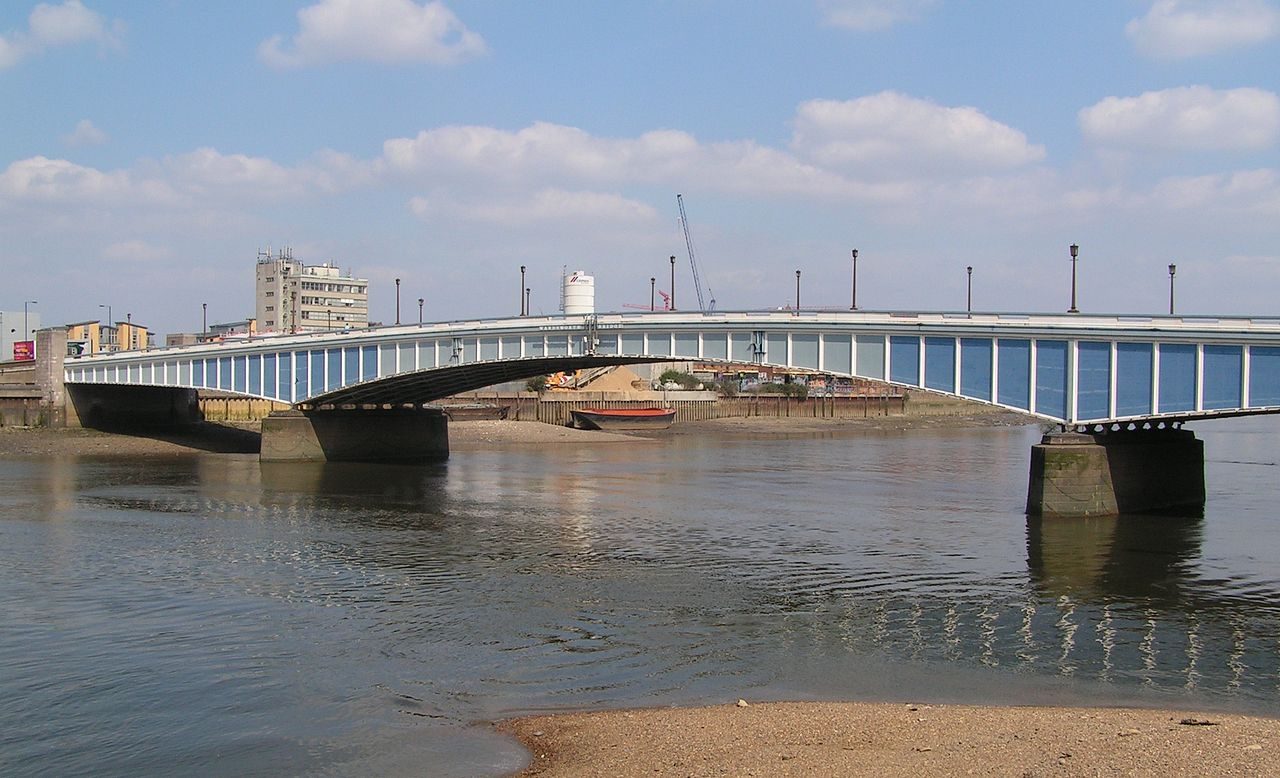
Battersea Railway Bridge
Date: 1863
Info: Designed by William Baker, the chief engineer of the London and North Western Railway, it opened as Cremorne Bridge (That’s still the name on its Grade II* listing.) It’s now owned by Network Rail, and they call it Chelsea River Bridge but no-one else does.
It’s a five-span wrought-iron arch bridge flanked by six brick arches on both shores. It carries two tracks and consists of five 120-foot lattice girder arches set on stone piers. This is one of the earliest railway bridges to cross the Thames and among the earliest surviving examples.
Nearby: Stroll to Brompton Cemetery to explore the Grade I listed garden cemetery.
Interesting Fact: It is the only bridge over the Thames that does not cross the river at right-angles. It is also the narrowest to cross the Thames – including all railway, underground and road bridges.
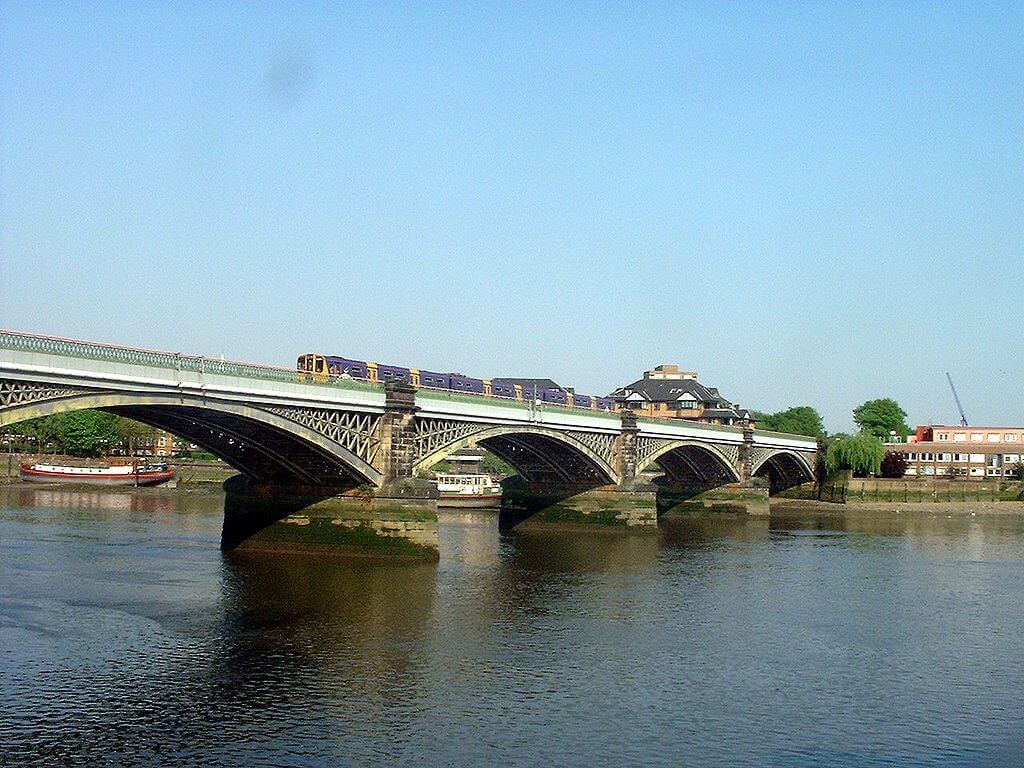
Battersea Bridge
Date: 1890
Info: The first bridge here was a wooden toll bridge that opened in 1771 to replace a ferry service. It was the most westerly London bridge at the time. Unfortunately, the bridge design wasn’t ideal as it had 19 arches so was often hit by river vessels. By the 1880s it was considered unsafe so was closed. It was the last surviving wooden bridge over The Thames in London at the time.
The replacement bridge was designed by that prolific civil engineer, Joseph Bazalgette and is now Grade II listed. Linking Battersea and Chelsea, Bazalgette’s design incorporated five arches with cast-iron girders on granite piers which in turn rest on concrete foundations.
Nearby: Head to Battersea Park for the boating lake, the London Peace Pagoda, the Children’s Zoo and lots of green space.
Interesting Fact: At just 40 feet across, Battersea Bridge is the narrowest road bridge in London.
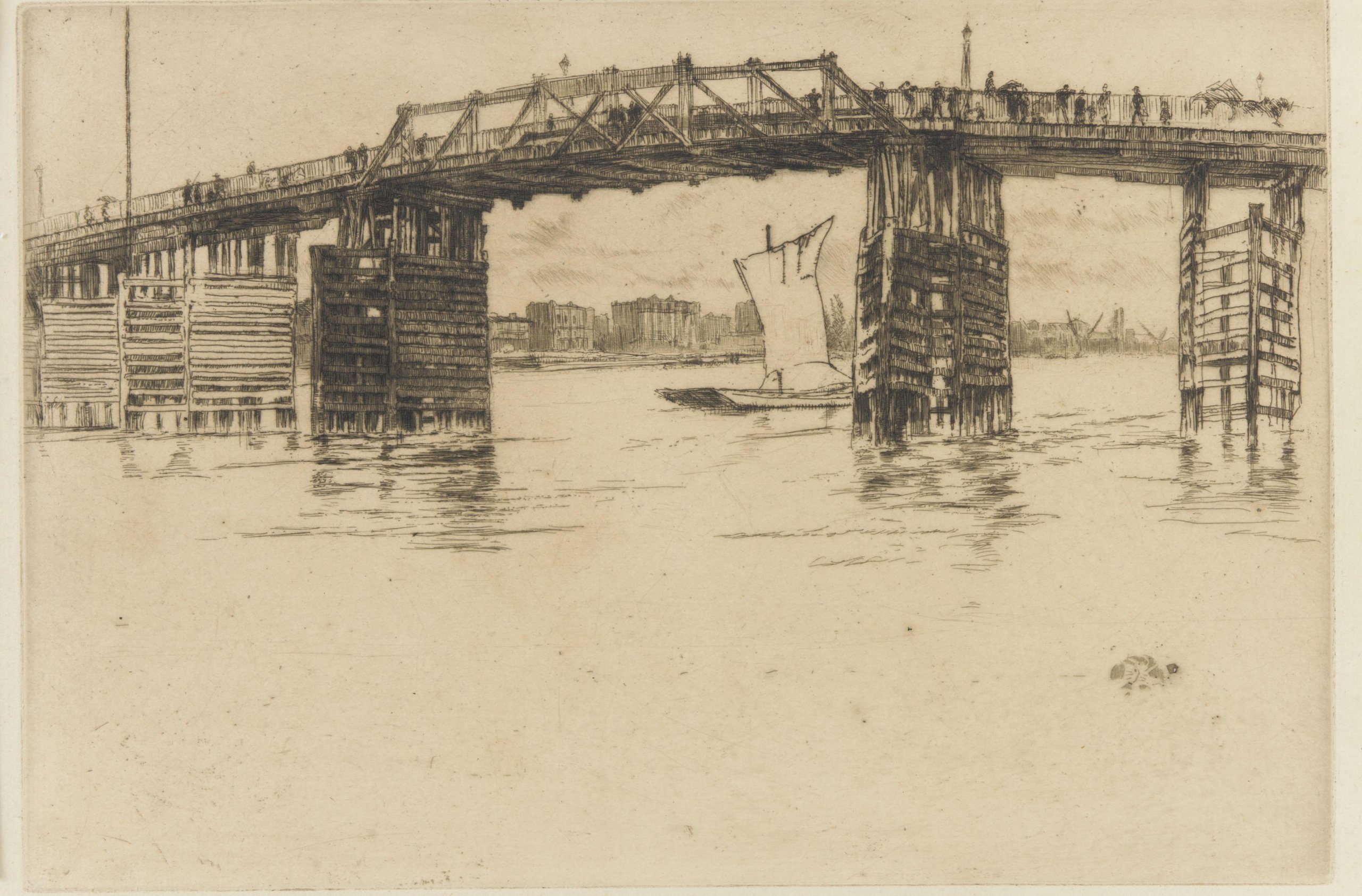
Albert Bridge
Date: 1873
Info: Albert Bridge is one of the most stunning London bridges but, structurally, it hasn’t been the most successful. It has been painted pink, blue and green since the 1990s to make it more visibility to river traffic, and it’s lit up at night with 4000 halogen bulbs. The name comes from Queen Victoria’s consort, Prince Albert, who suggested this new toll bridge in the 1860s.
It is located less than 500 yards from the 18th-century wooden Battersea Bridge site. To get approval to build, The Albert Bridge Company had to pay compensation to the owners of Battersea Bridge during construction and agree to buy the older bridge when the new one was finished.
Albert Bridge opened in 1873. It was designed by Rowland Mason Ordish and uses the Ordish-Lefeuvre system, a form of cable-stayed suspension bridge. (Ordish also worked on the Crystal Palace, Holborn Viaduct, St Pancras railway station and the Royal Albert Hall.) Unfortunately, similar bridges across the country had been known to collapse, especially when marching soldiers went over. (Broughton Suspension Bridge in what is now Greater Manchester collapsed in 1831 when 74 soldiers were crossing the bridge.) Albert Bridge became known as ‘The Trembling Lady’ because it shook when there were a lot of pedestrians crossing. The marching troops from nearby Chelsea Barracks caused the most concern so the local authority added signs stating “All troops must break step when marching over this bridge”. The signs can still be seen today (photo below) even though the barracks closed in 2008.
In 1884 Sir Joseph Bazalgette incorporated design elements of a suspension bridge to stabilise the structure, and in 1972 the Greater London Council added two concrete piers to support the central section of the bridge.
The Illuminated River project is working on lighting up 14 central London bridges. It reaches from Albert Bridge to Tower Bridge. Albert Bridge can be seen in lots of films and TV dramas. I was actually watching a BBC drama while writing this, and Albert Bridge was used. There’s lovely timing, eh? (I was watching ‘Us‘.)
Nearby: Carlyle’s House is a National Trust property, and Chelsea Physic Garden is London’s oldest botanical garden.
Interesting Fact: Albert Bridge was a tollbooth for just six years before it went into public ownership. It is the only London bridge with surviving tollbooths still in place.


Chelsea Bridge
Date: 1937
Info: The current Chelsea Bridge was part of an initiative supported by the Ministry of Transport to stimulate employment for young men in the Battersea area. It was also an attempt to encourage more international trade with materials deliberately sourced from around the former Empire, including asphalt from Trinidad and wood from Canada. Chelsea Bridge was opened in 1937 by Canadian Prime Minister Mackenzie King who was in London for the coronation of King George VI. The Grade II listed bridge was the first self-anchored suspension bridge in Britain.
This was a replacement for the 1858 river crossing. That had been opened by Queen Victoria on her way to the newly constructed Battersea Park. But when the structural problems became apparent, the name was changed to Chelsea Bridge.
In the 1970s, the bridge was painted in a red and white colour scheme. This upset Chelsea FC fans who thought it looked like the colours of their rivals Arsenal FC. In 2007, the bridge was repainted with a white with a red trim and blue along the balustrades.
Nearby: The National Army Museum is the British Army’s central museum. It’s next to the Royal Hospital Chelsea so you may well see some Chelsea Pensioners in the area.
Interesting Fact: During the construction of the current Chelsea Bridge, excavators discovered Roman and Celtic artefacts and skeletons on the riverbed. Historians believe this was the site where Julius Caesar first crossed the Thames during the 54 BC invasion of Britain.

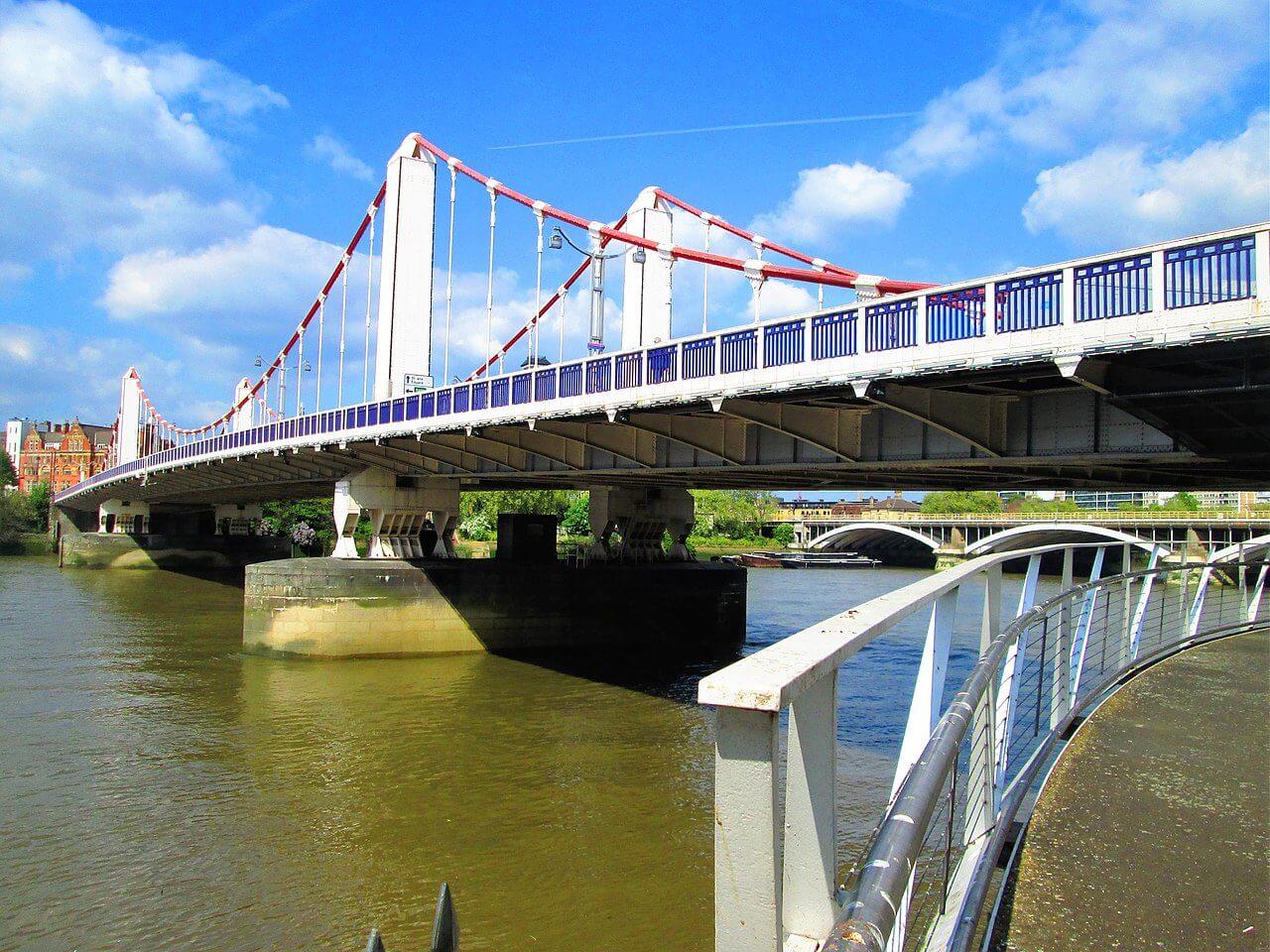
Grosvenor Bridge
Date: 1860
Info: This multi-track railway bridge takes trains into Victoria station. It was actually called Victoria Railway Bridge when it opened in 1860. While it seems like an unassuming architectural structure, it is significant as it was the first crossing over The Thames for a railway.
The bridge was designed by engineer John Fowler with just two railway lines. It has been expanded three times in 1866, 1907 and 1967 so it now carries ten tracks. Interestingly, these expansions have actually meant extra small bridges built next to it, so some say Grosvenor Bridge is really ten bridges.
In 1968, Grosvenor Bridge was said to be the busiest railway bridge in the world with 100 trains crossing per day. Today, it is still one of the world’s busiest railway bridges carrying over 200,000 passengers per day.
The bridge’s designer, John Fowler, helped introduce the Metropolitan Railway, the first incarnation of the London Underground. He was also chief engineer for the Forth Railway Bridge in Scotland — the longest in the world at the time of its completion in 1890.
Nearby: The iconic Battersea Power Station building can be seen from the bridge.
Interesting Fact: Spanning 177 feet, this is the widest bridge on the river – almost double the width of Westminster Bridge.

Vauxhall Bridge
Date: 1906
Info: This steel and granite arch bridge, designed by Sir Alexander Binnie, opened in 1906. The bridge we see today replaced the previous 19th-century toll bridge that was well used due to the popular Vauxhall Pleasure Gardens.
It is worth looking over the balustrades as the bridge is decorated with monumental bronze statues (twice life-size!) that are easily missed. On the upstream piers are Frederick Pomeroy’s Agriculture, Architecture, Engineering and Pottery (see photo below), whilst on the downstream piers are Alfred Drury’s Science, Fine Arts, Local Government and Education. My favourite tip is to look closely at ‘Architecture’ as it has a wonderful miniature scale model of St Paul’s Cathedral.
Vauxhall Bridge has been closed since 9 August 2020 for safety-critical repair work and is not expected to reopen until late November 2020.
Nearby: The Tate Britain art gallery remains free although we currently need to book a ticket.
Interesting Fact: One of London’s ‘lost rivers’, the Effra is diverted to meet The Thames here. (It’s now a storm relief sewer).
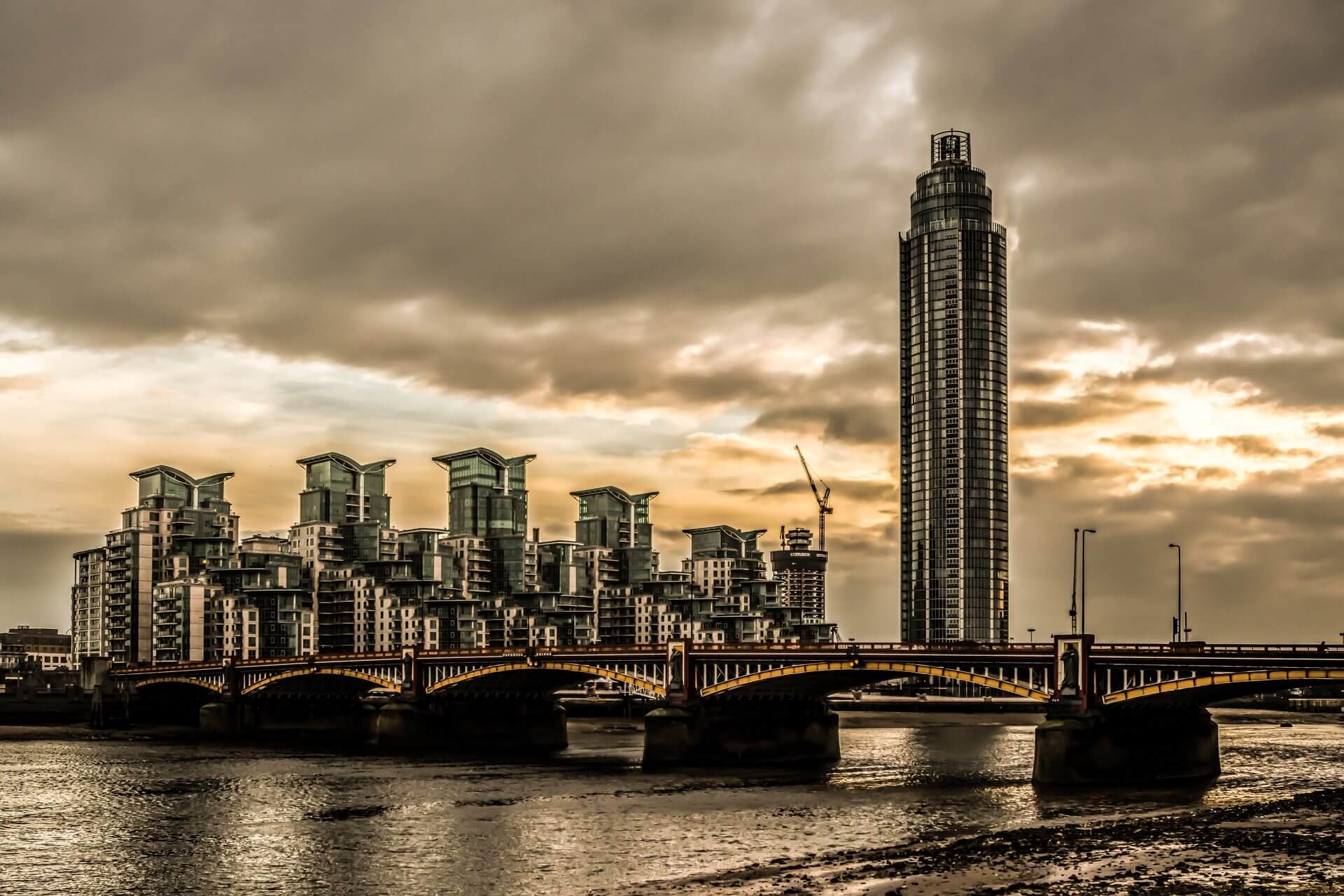
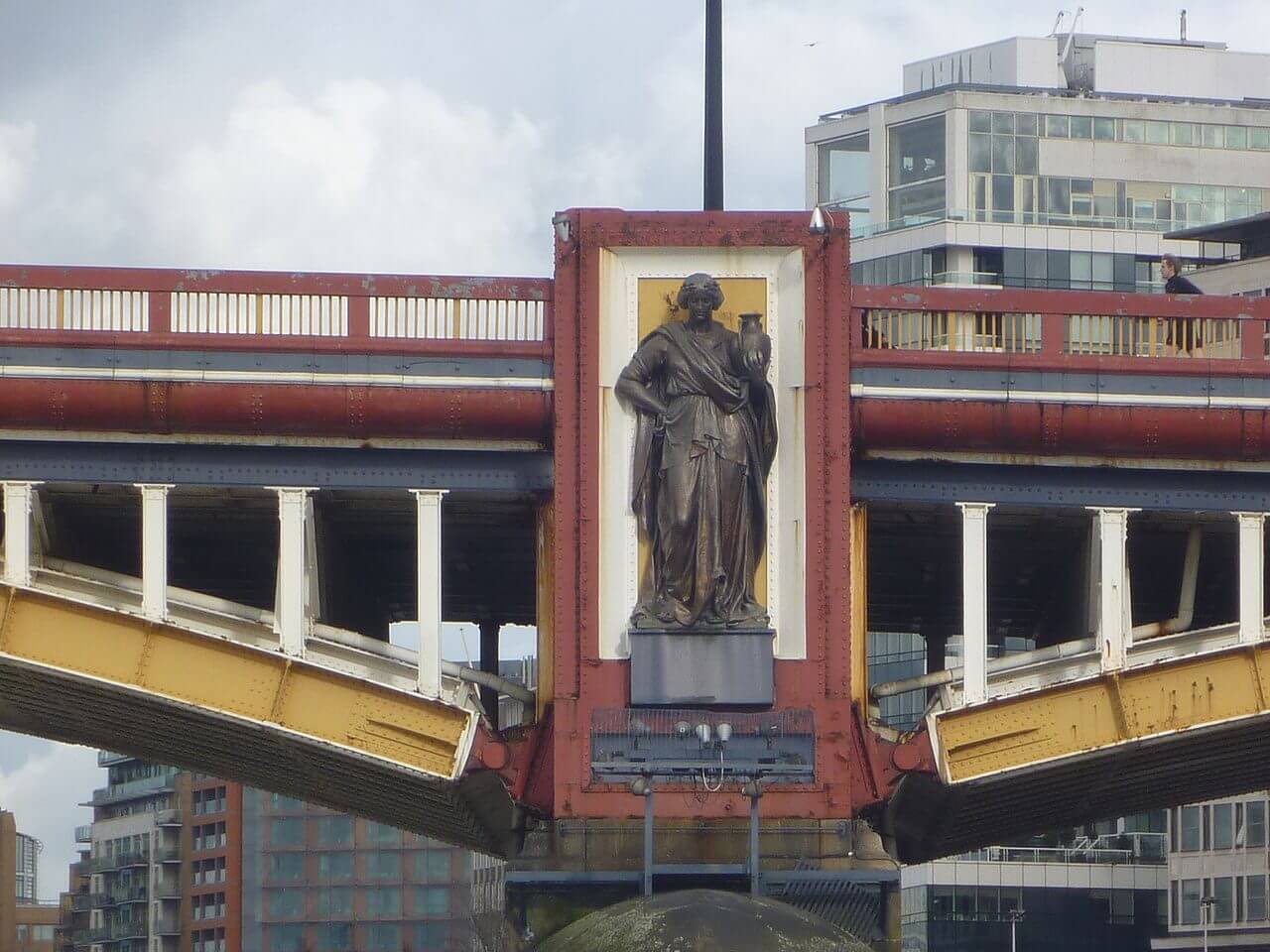
Lambeth Bridge
Date: 1932
Info: This five-span steel arch road bridge was opened in 1932 by King George V and Queen Mary. It is granite-faced and has decorative obelisks at either end and with piers and abutments clad in Cornish granite. Above each pier are the carved London County Council coats of arms, flanked by dolphins.
The obelisks appear to be topped with pineapples, but there is debate other whether they are actually pinecones. The pineapple theory is because, in the 17th century, the father and son in the Tradescant family were the Keeper of His Majesty’s Garden and it’s reported that John Tradescant the Younger cultivated the first pineapple to be grown on British soil. The pinecone theory is because they are considered an ancient symbol of hospitality.
Today’s bridge replaced an 1862 suspension bridge. The location was a popular horse and cart river crossing (they went by ferry before hence Horseferry Road) but the 19th-century bridge was too steep for heavily laden horse-drawn carts. The bridge was used by pedestrians but closed in 1911 when considered unsafe.
In 1965, Lambeth Bridge became the first of London’s crossings to be tunnelled beneath to provide pedestrian access along the embankment.
Nearby: The bridge is next to Lambeth Palace and the Garden Museum.
Interesting Fact: Lambeth Bridge is painted red to match the leather seats in the House of Lords, the part of the Palace of Westminster closest to the bridge.
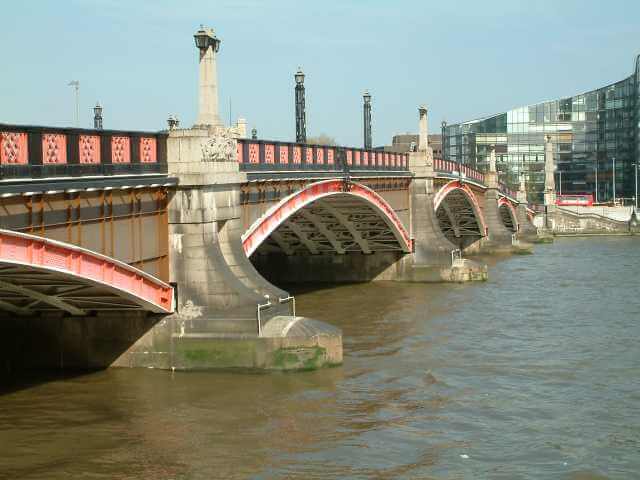
Westminster Bridge
Date: 1862
Info: Since the removal of Rennie’s New London Bridge in 1967, this is central London’s oldest surviving road bridge. It is an arch bridge with seven iron-ribbed elliptical spans; the most spans of any of the Thames bridges. It opened in 1862 and was designed by engineer Thomas Page. Sir Charles Barry, the architect responsible for rebuilding the Palace of Westminster after a fire in 1834, was taken on as an architectural consultant so that the bridge would blend in with his new Houses of Parliament (hence the Gothic revival detailing).
Westminster Bridge was painted green in 1970 to match the seats in the House of Commons, the part of the Palace of Westminster closest to the bridge. The bridge is part of the UNESCO World Heritage Site of the Palace of Westminster and is a Grade II listed structure.
The Old Westminster Bridge of 1750 was designed by Swiss engineer Charles Labelye. There was fierce opposition for a long time to building this second bridge over The Thames (there was only London Bridge at the time). The watermen did not want to lose their ferry crossing trade and were as forceful in their opinions as today’s black cab drivers, so they were compensated.
The old bridge had fifteen semi-circular arches in Portland and Purbeck stone. It was handsome and inspired many artists, including Canaletto and Claude Monet. In 1802 it inspired Wordsworth to write his poem Upon Westminster Bridge (about the view, not the bridge). The Gentleman’s Magazine described it as “a very great ornament to our metropolis, and will be looked on with pleasure or envy by all foreigners.” After the old London Bridge was removed in the 1830s, the river flow was affected, and the old Westminster Bridge began to show signs of decay.
Nearby: The Houses of Parliament is on the north side, and there is the start of London’s South Bank (with lots of attractions including the London Eye) on the Lambeth side.
Interesting Fact: Did the architect know? We’ll never for sure. But visit Westminster Bridge around 1 pm, and you may get to see the rude shadows on the pavement created by the trefoil cut-outs. (Photo below.)
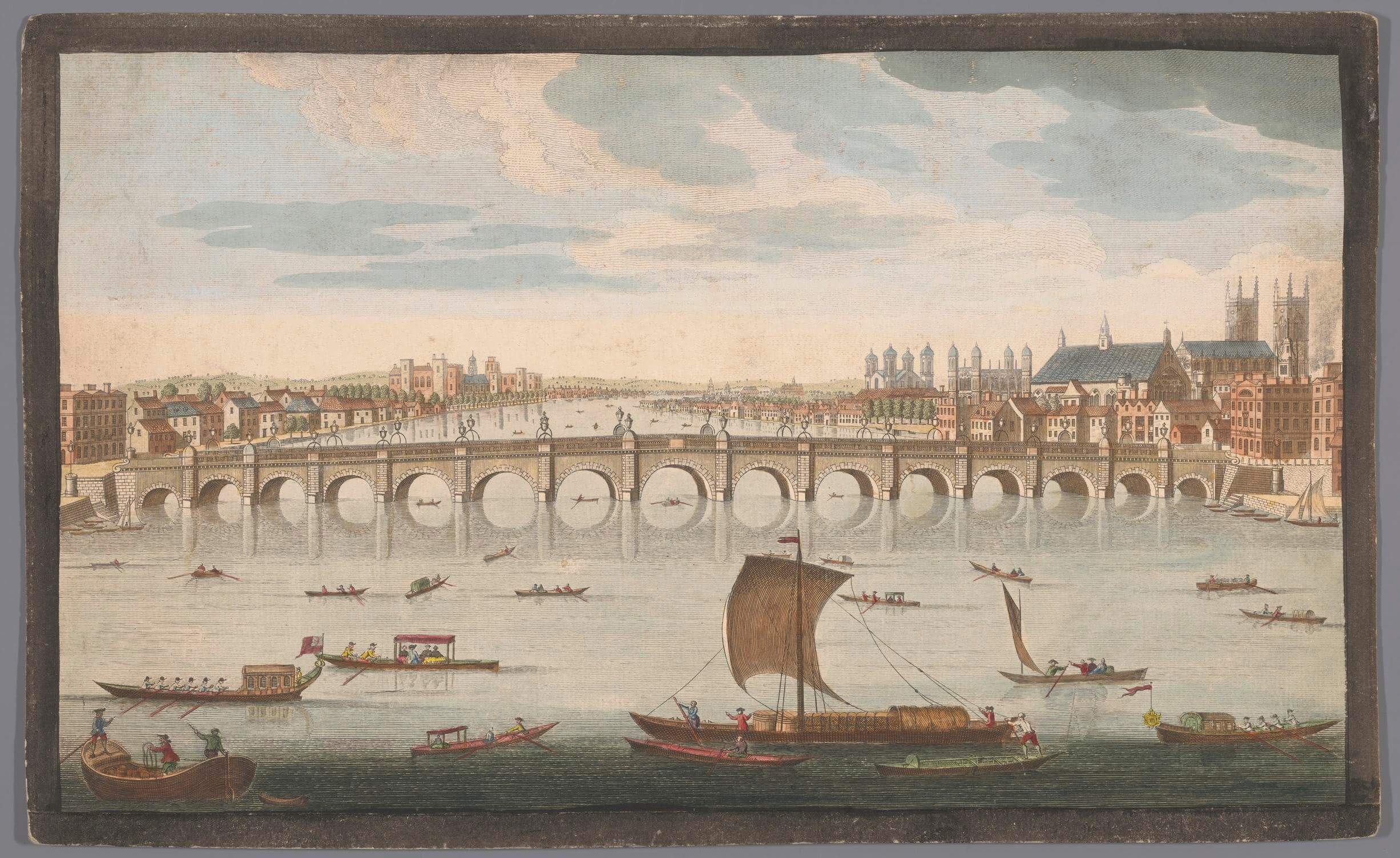
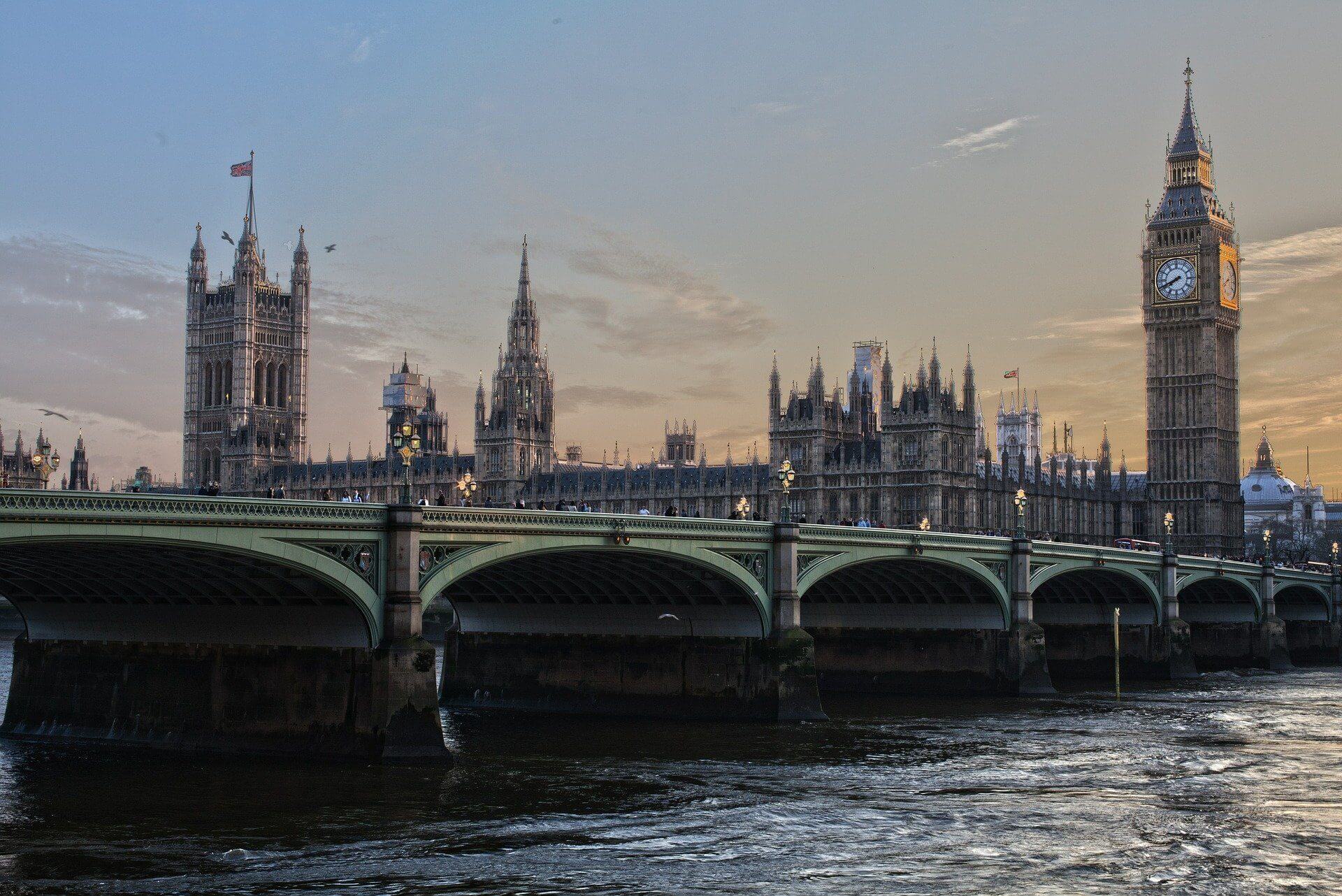

Hungerford Bridge and Golden Jubilee Bridges
Date: 1864 & 2002
Info: Hungerford Bridge is a steel truss rail bridge that we are supposed to call Charing Cross Bridge (but no-one does). It is flanked by the Golden Jubilee Bridges: two cable-stayed pedestrian bridges that were added in 2002.
The first Hungerford Bridge was a suspension bridge designed by Isambard Kingdom Brunel. It opened in 1845 as a footbridge to connect Hungerford Market on the north bank to a steamer pier on the south bank. It is probably the ‘iron bridge’ that Charles Dickens refers to in Little Dorrit. In 1859 the bridge was purchased by the South Eastern Railway Company who rebuilt it as a railway bridge. The chains from the bridge were reused by Brunel for his Clifton suspension bridge in Bristol. Hungerford Market closed in 1860 to make way for Charing Cross Railway Station.
The suspension bridge was replaced in 1864 with the bridge we have today. Designed by Sir John Hawkshaw, it has nine spans of wrought iron lattice girders. There were pedestrian walkways either side, but one was removed when the bridge was widened for more trains. The two new 15 ft wide Golden Jubilee footbridges were completed in 2002.
During the building of the Golden Jubilee Bridges, there were unexploded World War II bombs found in the riverbed, so some of the foundations had to be dug by hand. They also had to be careful of the Bakerloo Line as the tunnel was just a few feet away.
Nearby: London’s South Bank has lots of attractions. These bridges are next to the Southbank Centre.
Interesting Fact: The oldest photograph in the Museum of London’s collection first went on display for the Bridge exhibition at the Museum of London Docklands in 2014. It’s by William Henry Fox Talbot and is called ‘Old Hungerford Bridge’. It’s a salt print photograph and shows Isambard Kingdom Brunel’s original Hungerford Bridge in the year it opened – 1845. It was one of the longest suspension bridges at the time (1,462ft) but was demolished, ironically, within 15 years to make way for a railway bridge.
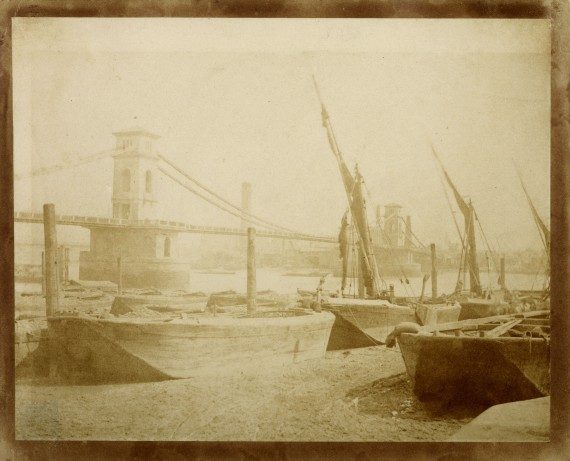
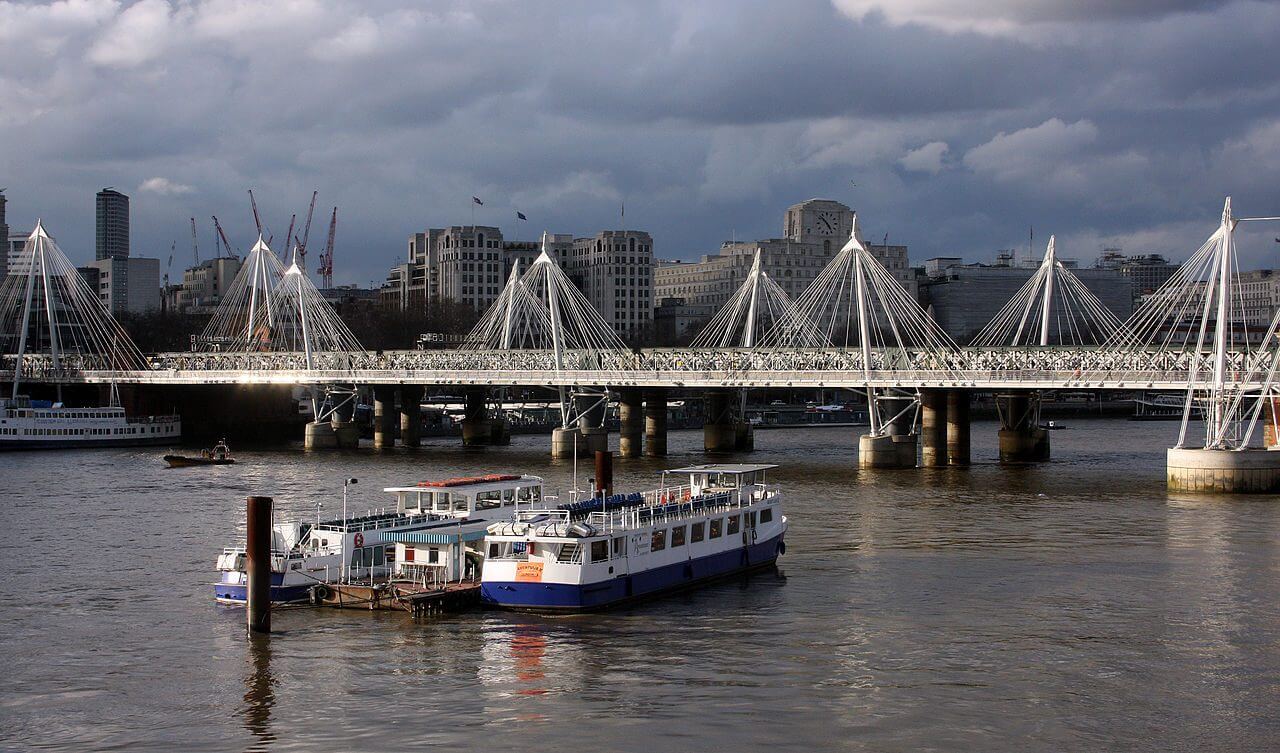
Waterloo Bridge
Date: 1945
Info: This Grade II* listed reinforced concrete bridge was designed by Giles Gilbert Scott who was also responsible for Battersea Power Station, Bankside Power Station (now Tate Modern) and the classic red telephone boxes. At 1,230 feet long and 80 feet wide it is the longest bridge in London and was the first to incorporate electric lights. Some refer to it as the ‘Ladies Bridge‘ as many women had to take on construction jobs during WWII. It was the only bridge in London to suffer multiple hits by German bombers, but it was finally finished in 1945.
It replaced the 1817 bridge that was designed by John Rennie the Elder (who also designed the 1831 London Bridge and it was built by his sons. That’s the one that’s now in Arizona.) It was going to be called the Strand Bridge as it was built by the Strand Bridge Company, but the name was changed to commemorate the victory of the British, Dutch and Prussians at the Battle of Waterloo in 1815.
By the beginning of the 19th century, the population of London was already over a million. The wear and tear on the bridge meant it was closed in 1924 to be demolished and replaced.
Thanks to Waterloo Bridge’s location at a strategic bend in the river, the views from the bridge (of Westminster, the South Bank and the London Eye to the west, and of the City of London and Canary Wharf to the east) are widely held to be the finest from any spot in London at ground level.
Nearby: Somerset House is on the north side of The Thames, and the National Theatre is on the South Bank.
Interesting Fact: In 1868, an Iron Age helmet dating from 150-50 BC was recovered from the Thames riverbed at this point. It is the only Iron Age horned helmet to be found in all of Europe. Nicknamed the ‘Waterloo Bridge Helmet,’ it can be seen in the British Museum.
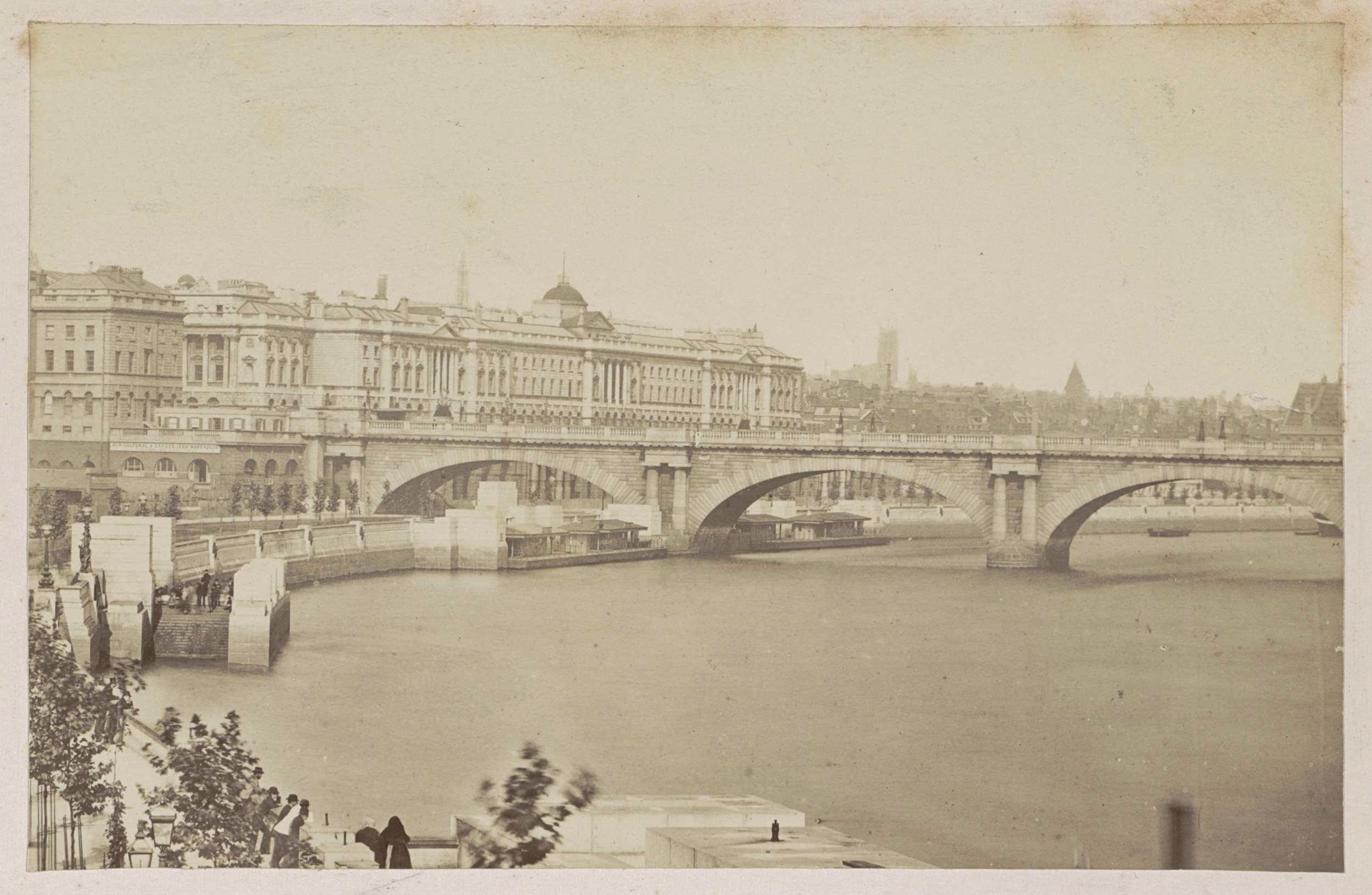
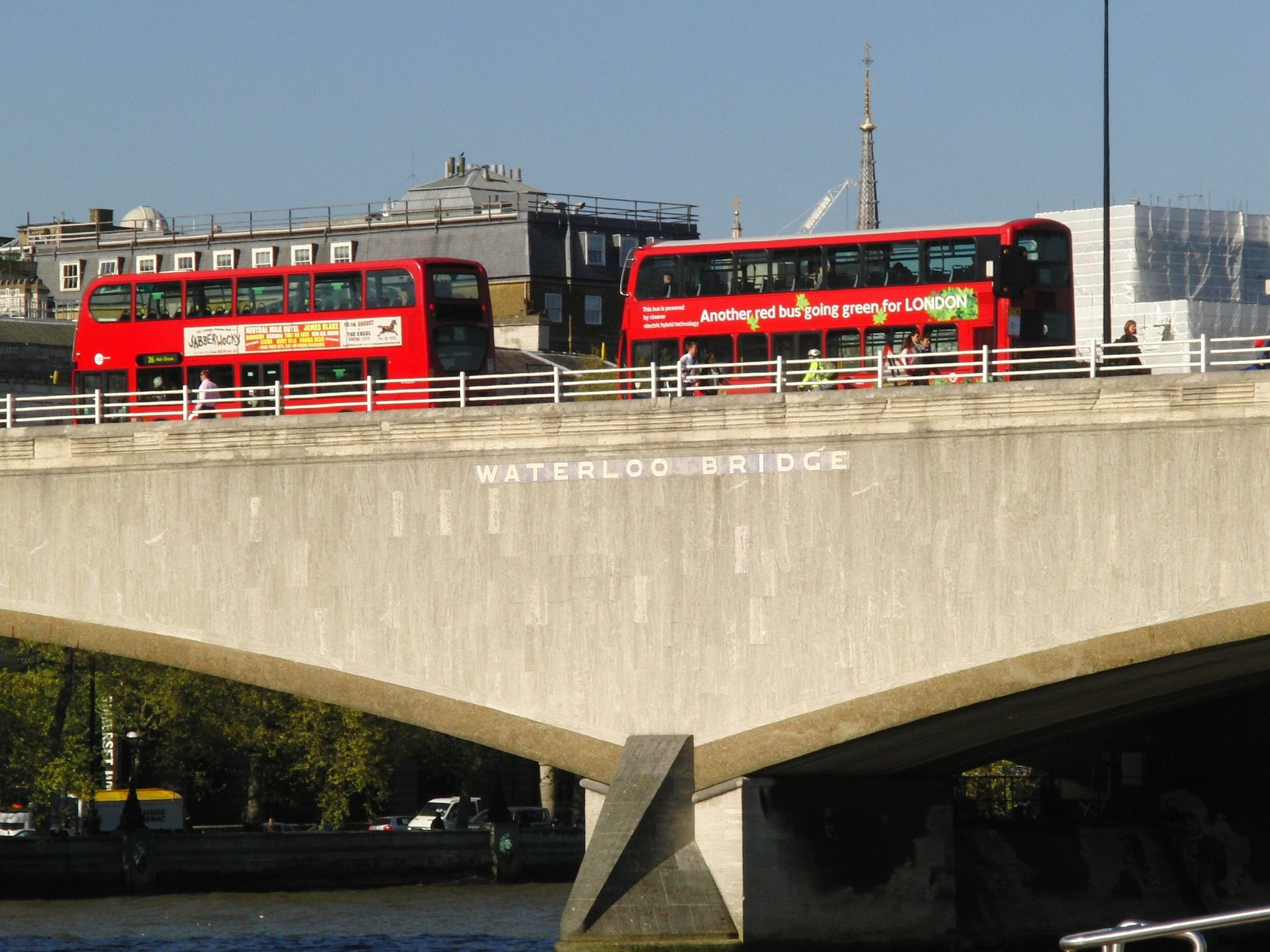
Blackfriars Bridge
Date: 1869
Info: Blackfriars Bridge was designed by Joseph Cubitt, son of William Cubitt and opened by Queen Victoria in 1869 when she also opened nearby Holborn Viaduct. Joseph had also designed the first Blackfriars Rail Bridge (1864) — now demolished except for its impressive red cast-iron Doric columns, which can still be seen in the river.
This was the first bridge to have five elliptical wrought-iron arches so as not to create cross-currents and disrupt river traffic. It has granite piers topped with ornately carved pulpits as a reminder of the ancient Blackfriars monastery. It is said to be the tidal turning point – the boundary between seawater and saltwater in the Thames – so is decorated to the east (downstream) with images of seabirds and to the west (upstream) with freshwater birds. The bridge also marks the boundary of the historic City of London with its southern landing guarded by a statue of a silver dragon. The bridge was widened in 1910 and is now the widest bridge over the Thames in London.
This replaced the original Blackfriars Bridge that opened in 1769 as The William Pitt Bridge. (It was the third bridge over the Thames following London Bridge and then Westminster Bridge in 1750.) It had 19th-century repairs but needed replacing. Robert Mylne’s original design can still be seen on the decorative tiles in the bridge’s southern pedestrian subway.
Nearby: Tate Modern is on the south side of the river.
Interesting Fact: Rennie Garden, a small pocket park at the south end of the bridge is actually owned by the City of the London (which is on the north side of the bridge).
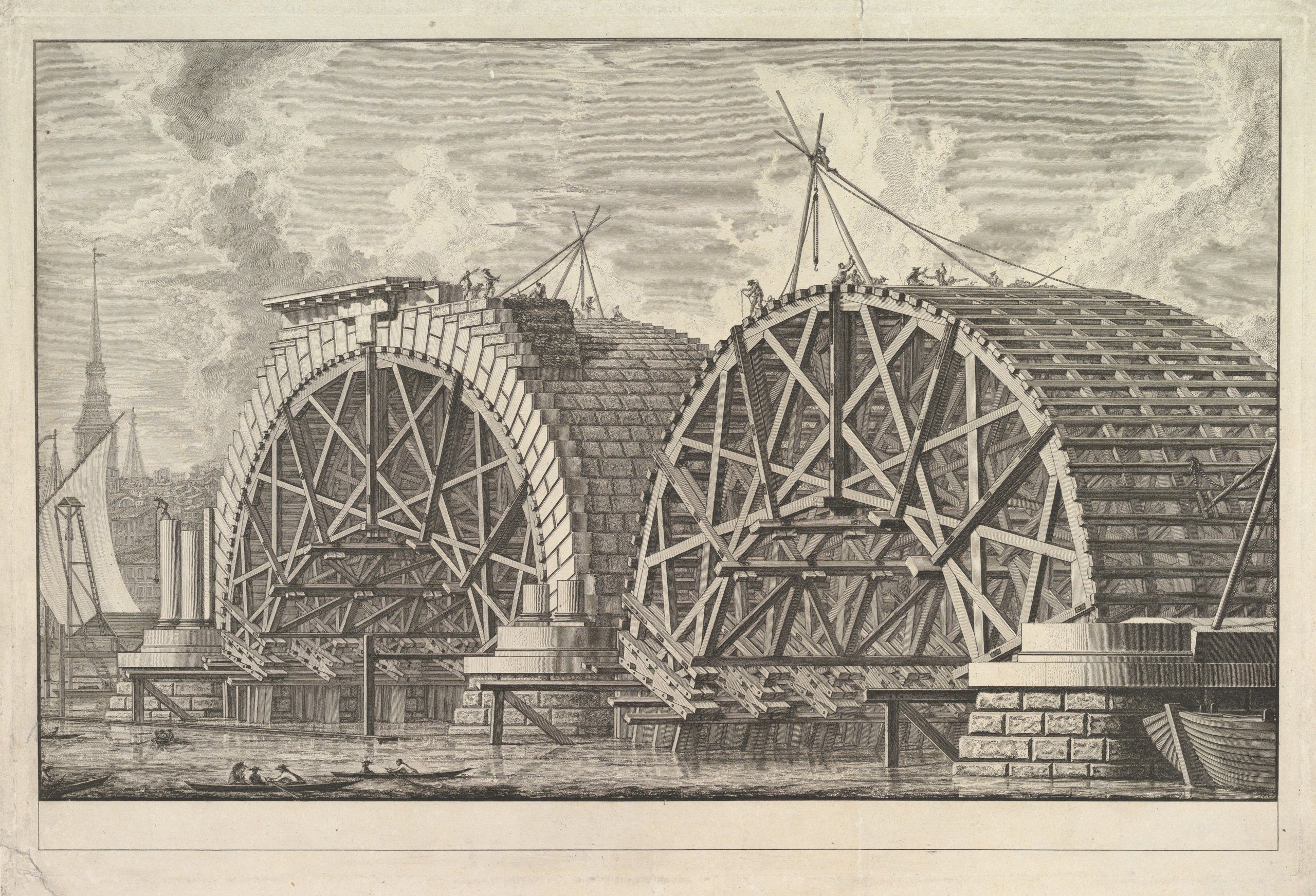

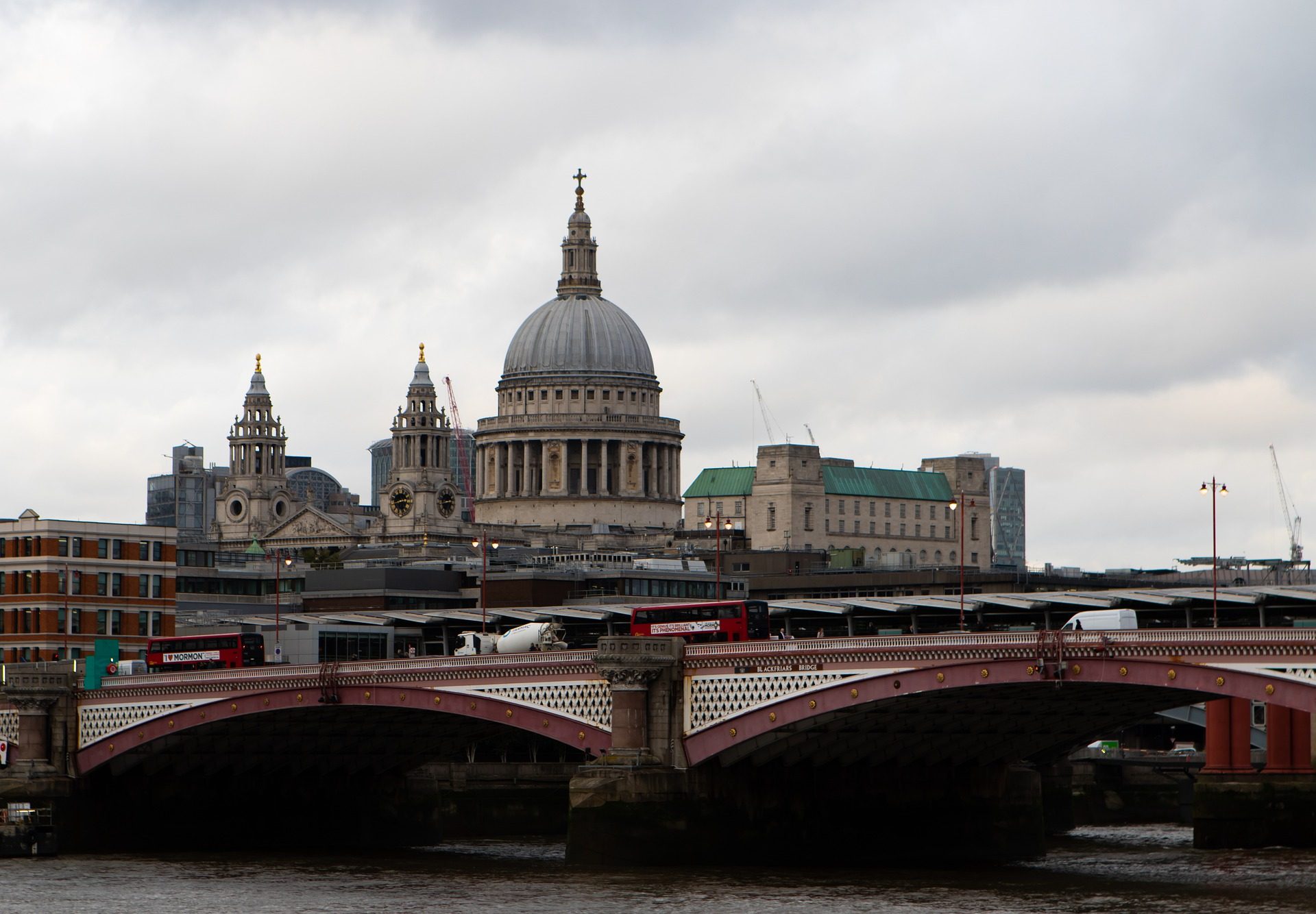
Blackfriars Railway Bridge
Date: 1886
Info: Completed in 1886, the bridge was designed by Isambard Kingdom Brunel’s second son, Henry Marc Brunel, and John Wolfe-Barry who also designed Tower Bridge. It was called St Paul’s Railway Bridge and connected with the new St Paul’s Railway Station on the north bank. But when St Paul’s railway station changed its name to Blackfriars in 1937 the name of the bridge was changed as well. It’s a wrought iron arch viaduct bridge and now has solar panels on the station roof.
The current bridge replaced the 1864 bridge designed by Joseph Cubitt for the London, Chatham and Dover Railway. This wasn’t strong enough for modern trains, yet it wasn’t demolished until 1995. As mentioned above, you can still see the red support columns in the river.
Nearby: The Blackfriars pub, on the north side, is an Art Nouveau Grade II* listed building shaped into a narrow wedge.
Interesting Fact: This is not just a railway bridge but also a railway station as Blackfriars is accessed at both ends, and you board the trains on the bridge.
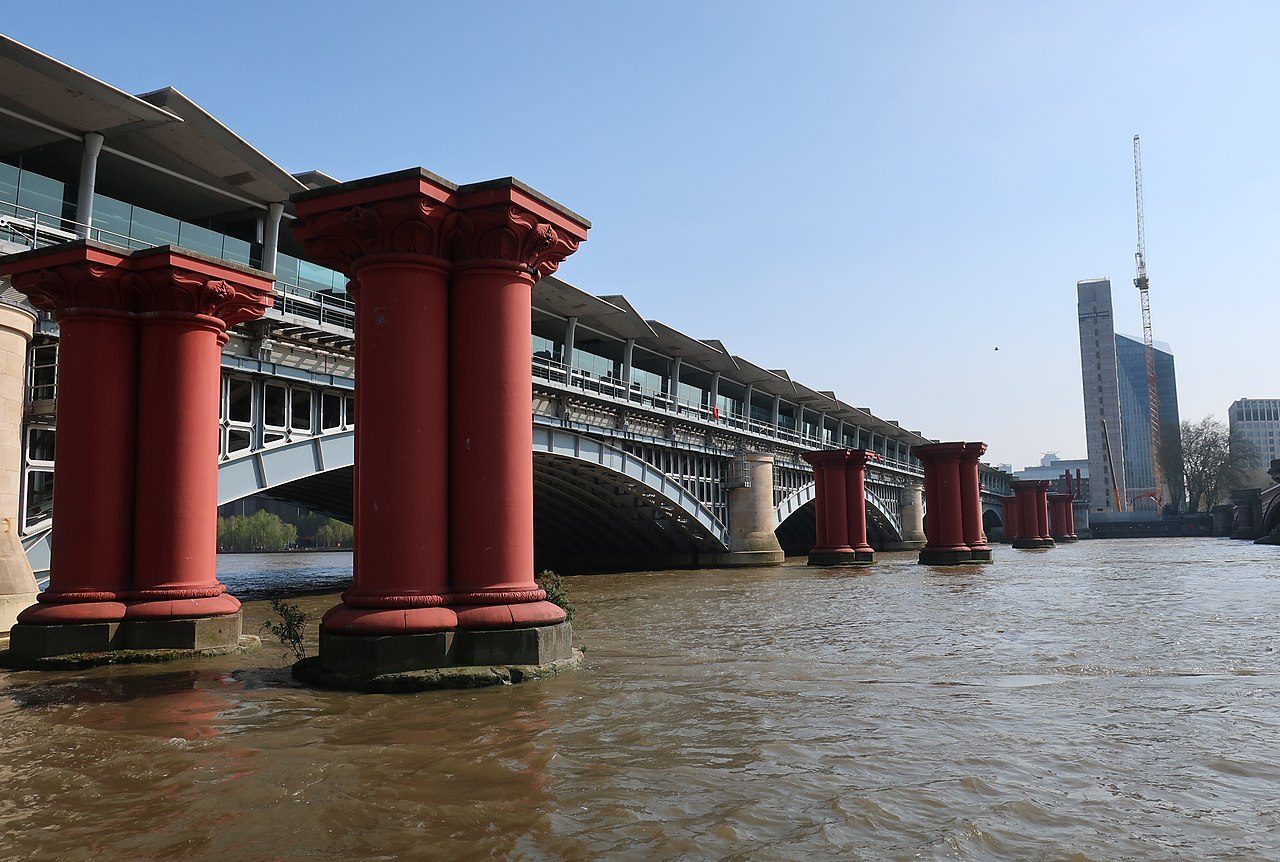
Millennium Bridge
Date: 2002
Info: This steel suspension footbridge connects the City of London and the South Bank. It opened in June 2000 but then, two days later, closed as people found it was too “wobbly”. Dampers were added, and it reopened in February 2002. The design for London Millennium Bridge was envisioned by Arup (engineers), Foster and Partners (architects) and Sir Anthony Caro (sculptor).
This 325-foot long structure was London’s first new pedestrian bridge for over a century. You’ll see padlock love locks on the tension cables along the side. And look down, and you might spot Ben Wilson’s chewing gum art – amazing miniature paintings on discarded chewing gum (see an example below).
Nearby: St Paul’s Cathedral is centrally aligned to the north. Tate Modern and Shakespeare’s Globe are at the bridge’s southern end.
Interesting Fact: An Act of Parliament is usually needed for a new bridge over The Thames, but this was avoided as the Port of London Authority granted a licence, and the City of London and London Borough of Southwark granted planning permission.

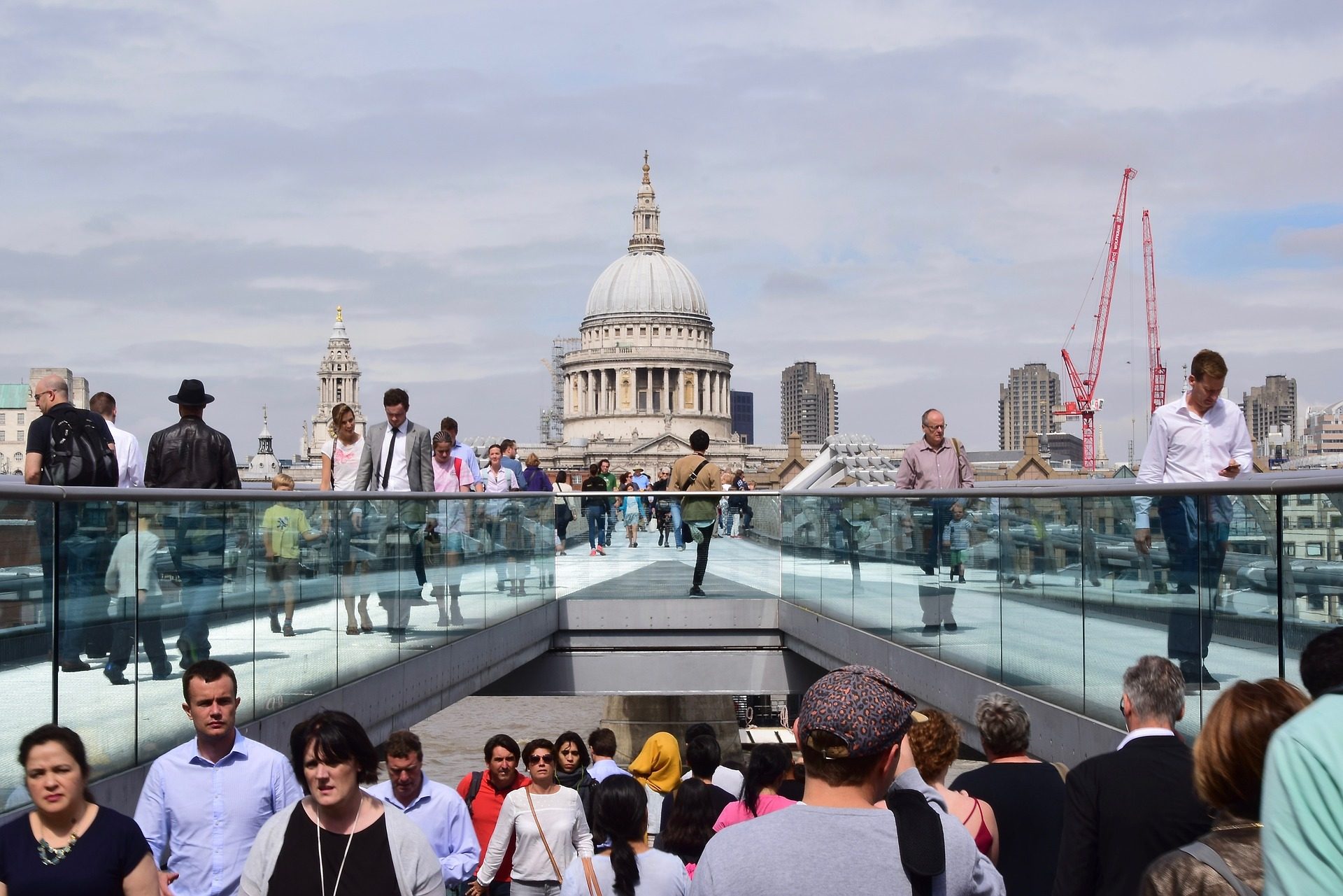

Southwark Bridge
Date: 1921
Info: Southwark Bridge is a Grade II listed steel arch bridge with five spans; designed so that the granite piers lined up with those of Blackfriars Bridge and London Bridge to make it easier for river traffic to travel through as it reduces the risk of crosscurrent. It opened in 1921, after significant construction delays during the First World War, and was designed by architect Sir Ernest George and engineer Basil Mott. The bridge cuts through the site of the original Shakespeare’s Globe.
The bridge consists of cast-iron arches with abutments and balustrades of grey granite and is painted green and yellow with sentry-box like structures on the turreted pier headings. Unlike London and Blackfriars Bridges, Southwark Bridge does not have silver dragons to mark the city boundary on the southern bank of the Thames, as its construction was privately financed.
This bridge replaced an earlier Southwark Bridge (known as Queen Street Bridge) that was designed by John Rennie the Elder and opened in 1819. The official opening was held at midnight to show off the lighting provided by 30 gas lamps. It was the largest cast-iron structure of its era, but it was underused and lacked the strength to carry heavy goods vehicles. The centre span of the old Southwark Bridge was said to be the widest cast iron span ever built, at 240 ft wide. (A span is the distance between two supports for a bridge.)
Nearby: The London Mithraeum (aka Temple of Mithras) is a short walk away in The City.
Interesting Fact: On the north bank of Southwark Bridge, there’s a pedestrian tunnel with a wall mural that depicts scenes of the Thames frost fairs. In several winters between the 17th and early 19th centuries, the Thames froze over giving Londoners the opportunity to set up festivals with food stalls, shops, sporting events and even temporary pubs on the ice.
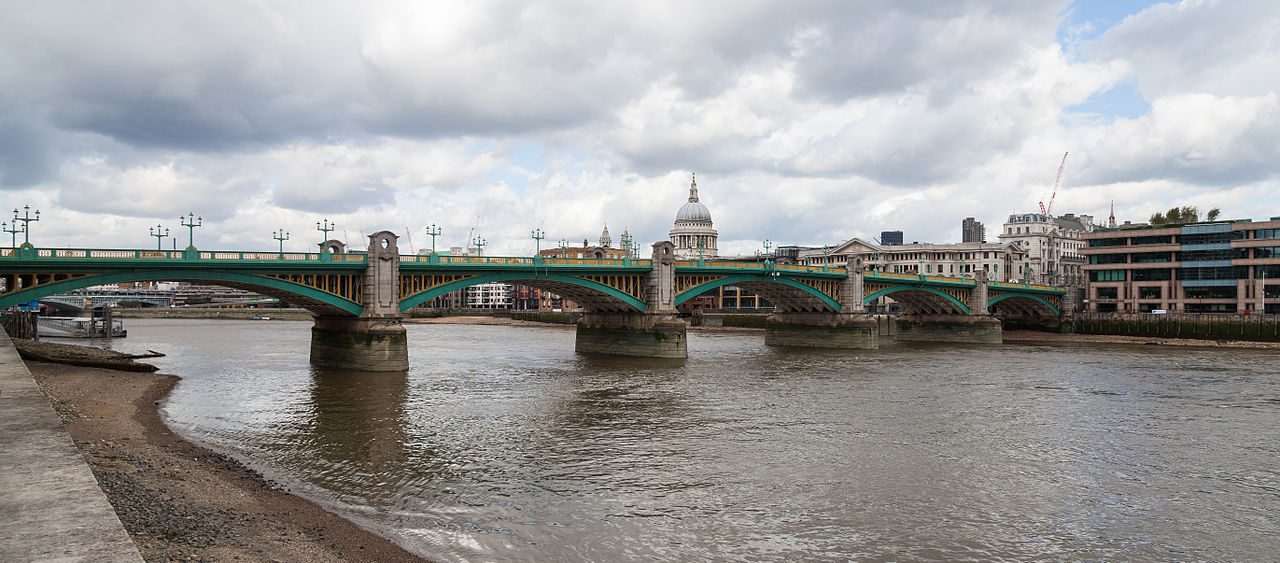

Cannon Street Railway Bridge
Date: 1866
Info: Cannon Street Bridge, designed by Sir John Hawkshaw, opened in 1866 for the new Cannon Street Station. It was officially named the Alexandra Bridge in honour of Princess Alexandra of Denmark, who married Edward, Prince of Wales, in 1863. It is a five-span bridge with cast-iron Doric columns and wrought iron plate girders.
There were footpaths until 1893 when the bridge was strengthened and widened. The bridge was strengthened and considerably rebuilt again in 1913 for heavier loads. The most recent major works were in the early 1980s for further strengthening.
Nearby: Borough Market is close.
Interesting Fact: Cannon Street Station was damaged during the Second World War, and many of the original ornamental features were removed when British Rail undertook extensive renovations to the structure in 1982. However, two brick towers from the original bridge remain on the riverfront. These towers flank the bridge on the north side and conceal large tanks that contain enough water to power Cannon Street station’s hydraulic lifts.
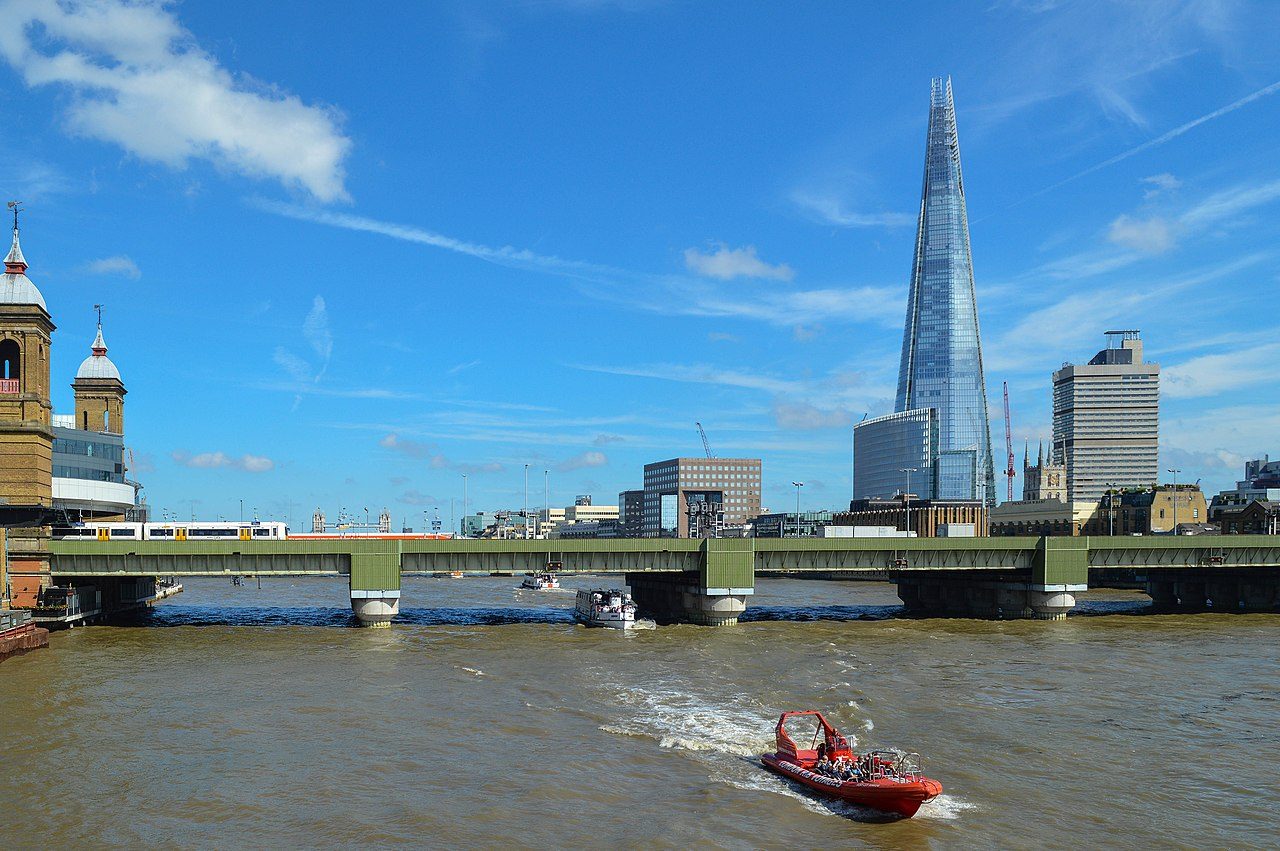
London Bridge
Date: 1973
Info: This whole article was inspired by the research I did on London Bridge.
Today’s concrete bridge was opened in 1972, but the history of the previous bridges here is fascinating. London Bridge was the only bridge across the Thames until Westminster Bridge arrived in 1750. There was a medieval bridge which lasted 600 years followed by a 19th-century bridge designed by John Rennie the Elder (the architect for the first Waterloo Bridge) and built from his design by his sons as it was constructed after his death. That bridge still survives in a new location in the US.
Nearby: You can get London’s highest view at the 1,020-foot high Shard.
Interesting Fact: I also discovered that stones from the old versions of London Bridge can be found across London.
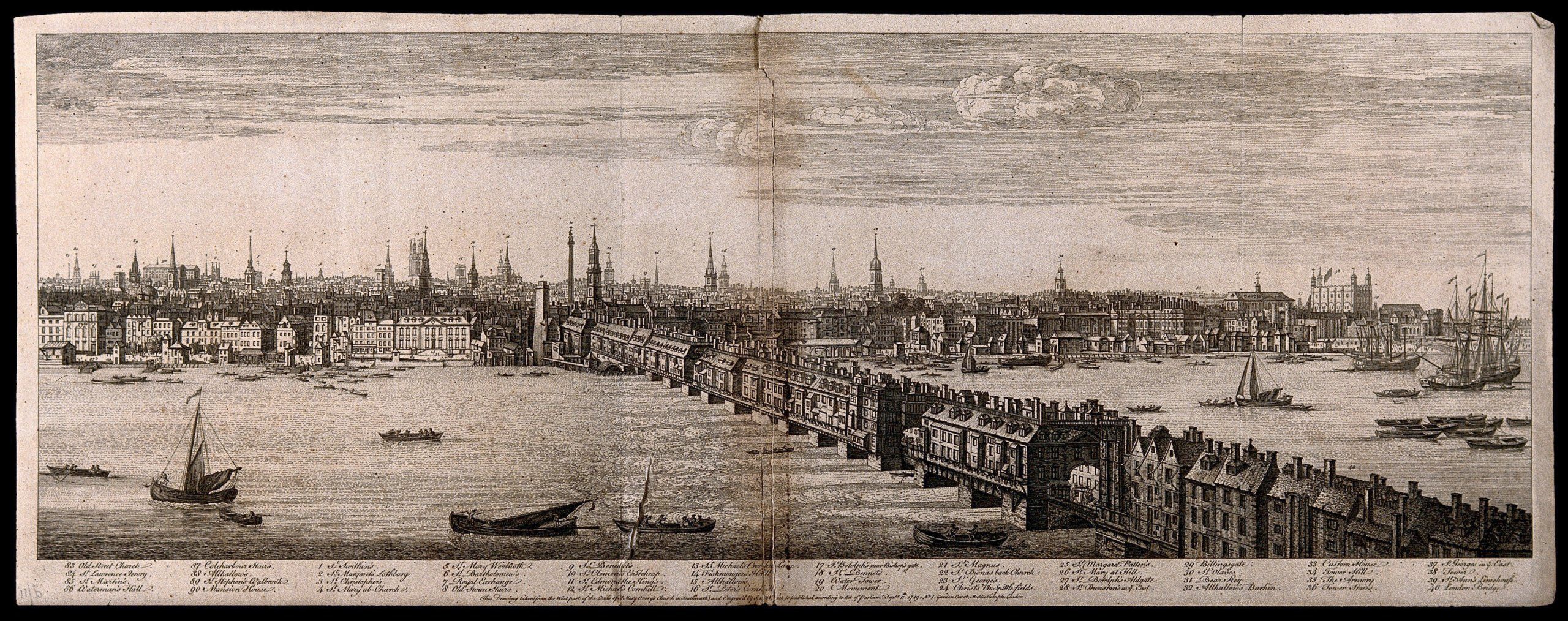
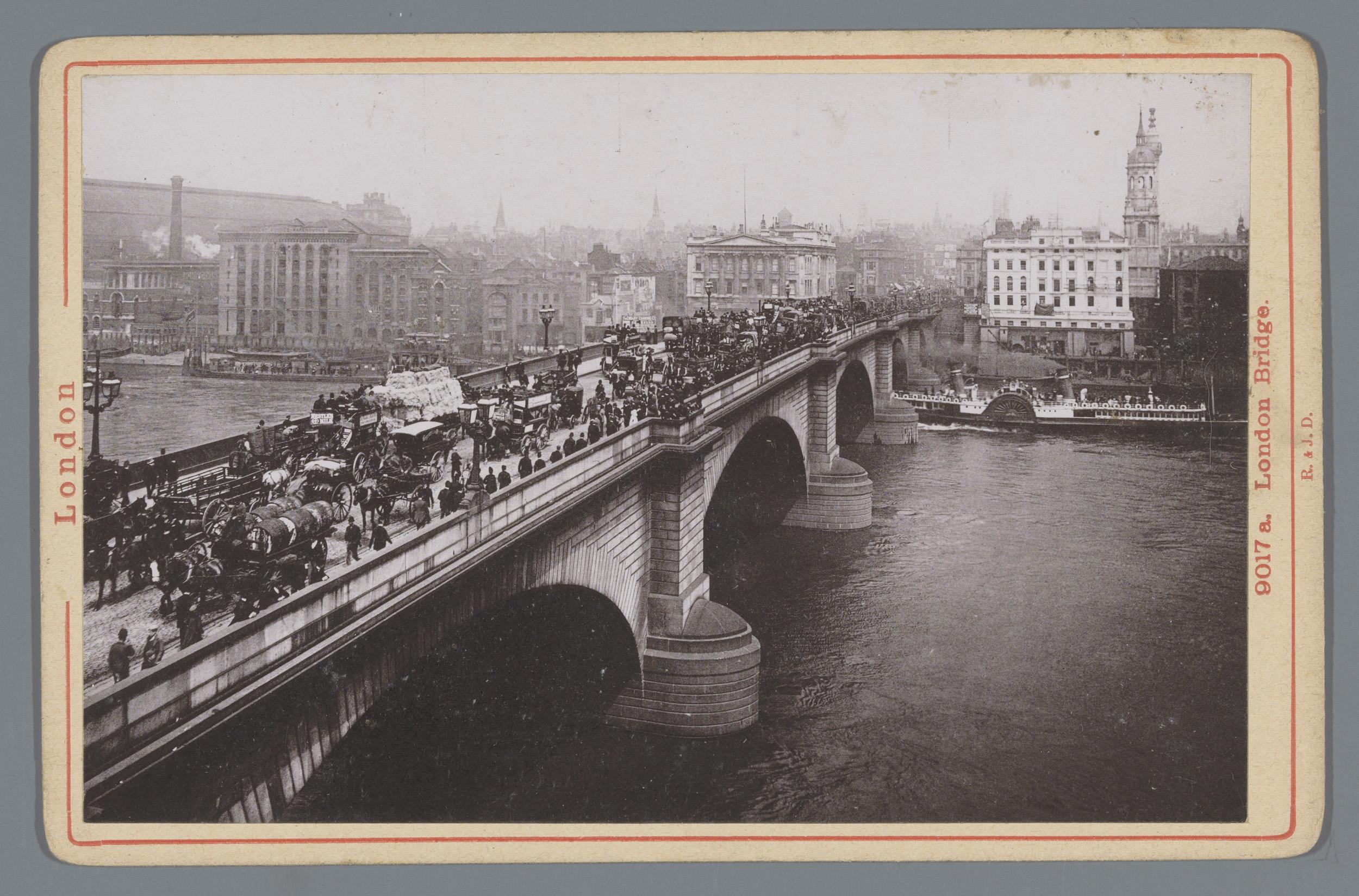
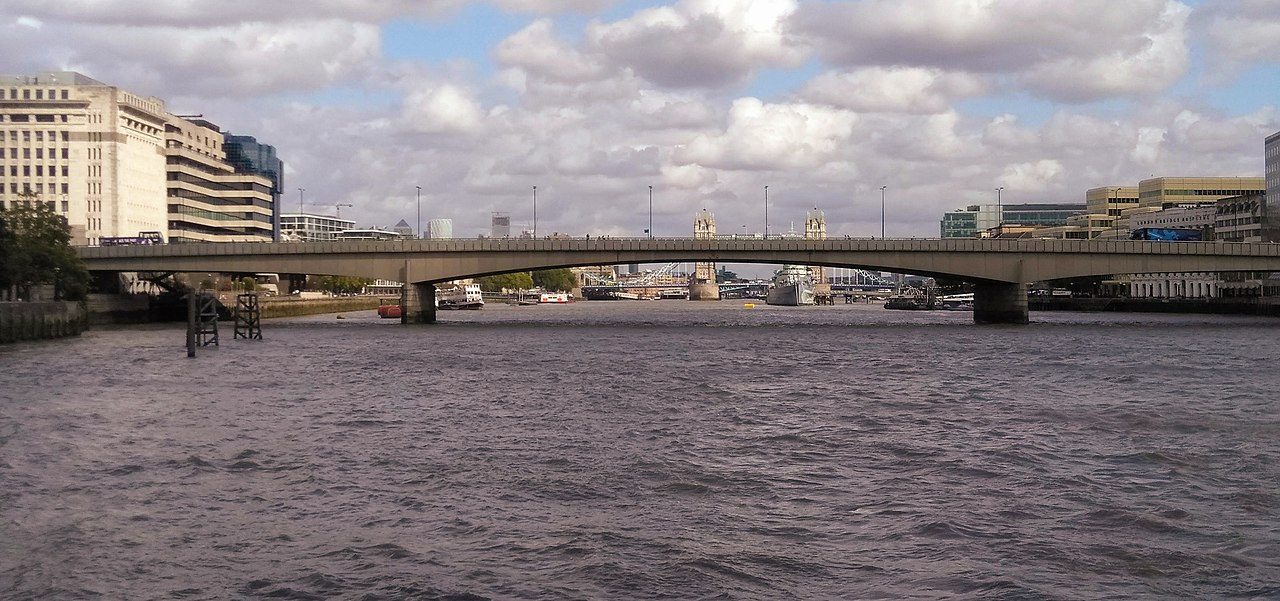
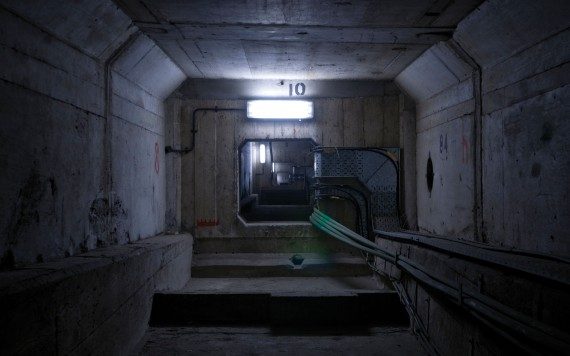
Tower Bridge
Date: 1894
Info: Iconic and Grade I listed, Tower Bridge opened in 1894 and was originally painted chocolate brown (Queen Victoria’s favourite colour, apparently). It’s a combined bascule and suspension bridge that still opens about 800 times a year for taller vessels. The two horizontal high walkways opened in 1982 as the Tower Bridge Experience and there was a 36 ft glass walkway added in 2014. Ticketholders can also see the original steam engines.
The engineer was Sir John Wolfe Barry, the youngest son of the famous architect Sir Charles Barry who remodelled the Palace of Westminster (Houses of Parliament) in the 19th century. The architect was Sir Horace Jones who, as the architect and surveyor to the City of London, also designed Smithfield Market and the stunning Leadenhall Market (the one everyone associates with Harry Potter’s Diagon Alley).
Nearby: At nearly 1000-years-old, Tower of London has been a royal palace, a prison, an armoury, a zoo and so much more. Incredible history in one location. And you get to see the Crown Jewels.
Interesting Fact: Tower Bridge is the only London bridge this is a registered visitor attraction. It welcomes over half a million visitors each year.

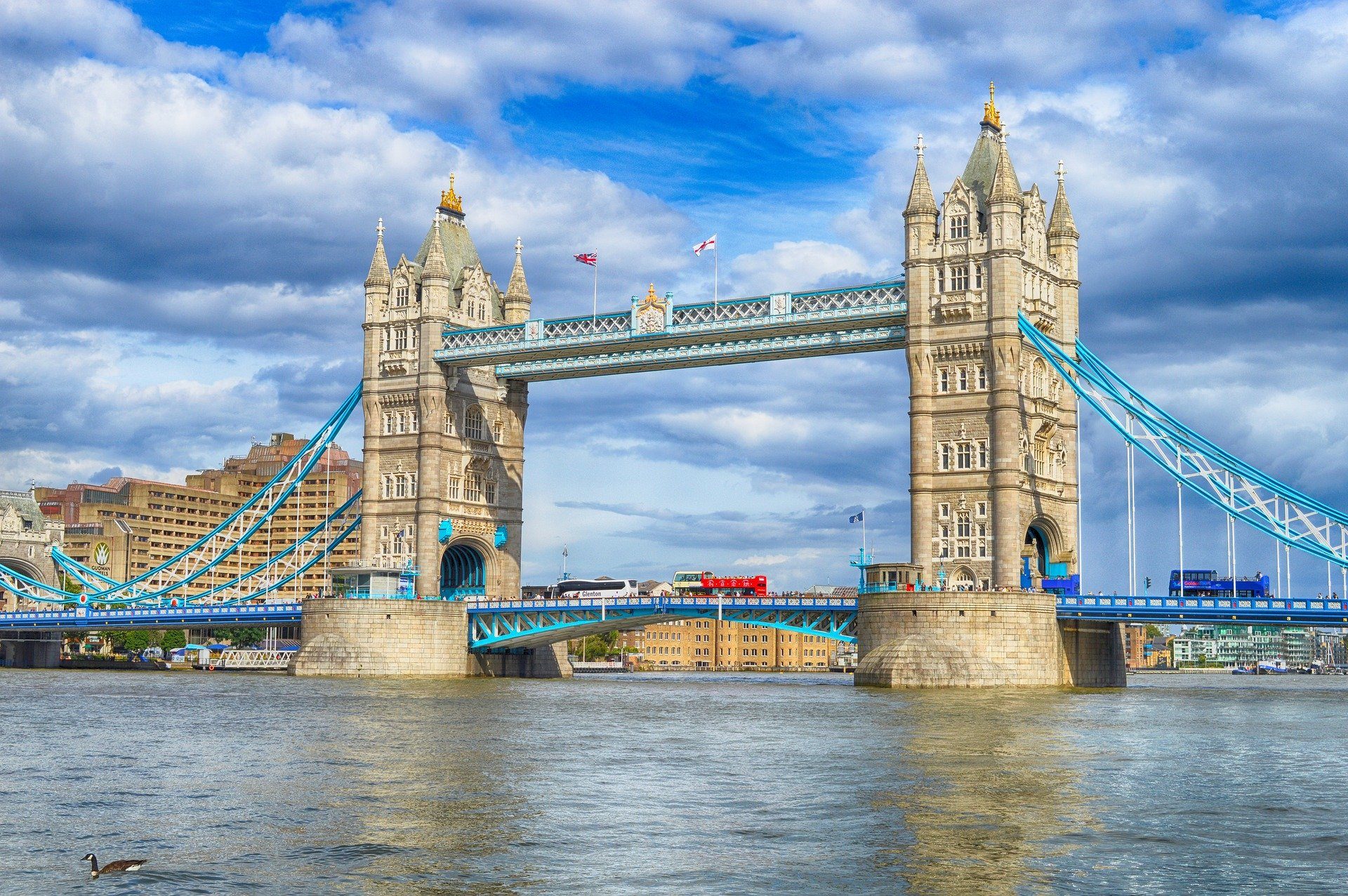
A Little Bit of London In Your Inbox Weekly. Sign-up for our free weekly London newsletter. Sent every Friday with the latest news from London!



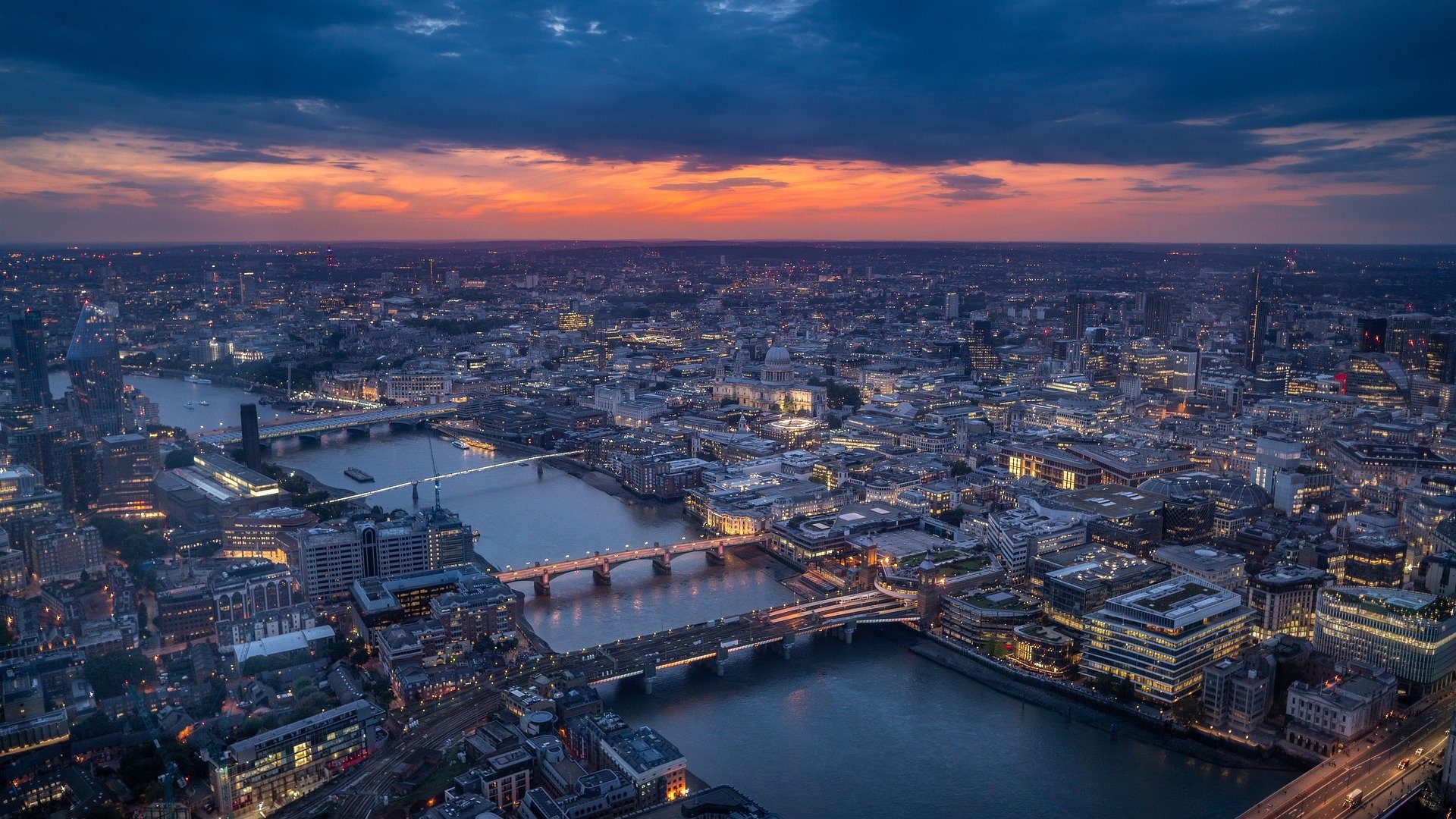
Kew rail bridge my favorite.
Featured articles never disappoint. Love the info on the bridges. Will visit London again. Let’s pray for Covid to disappear.
Forgot to mention that Cannon Street Bridge looks quite lovely in the photographs of this article